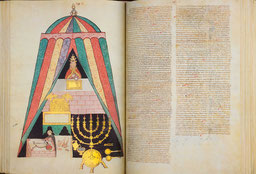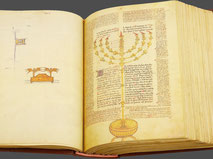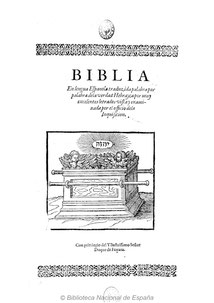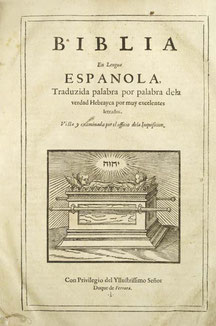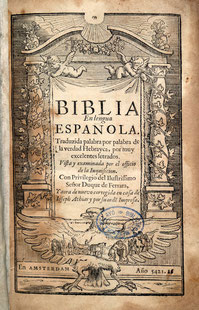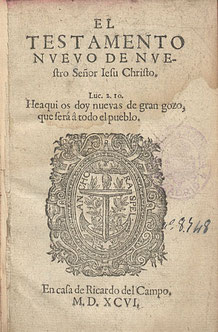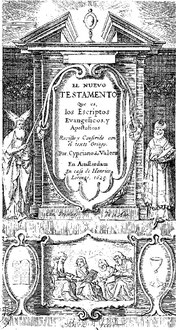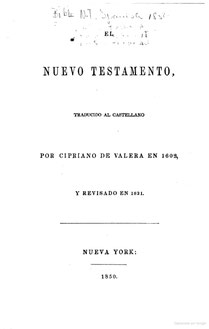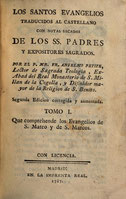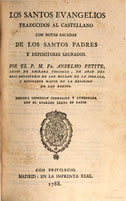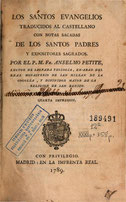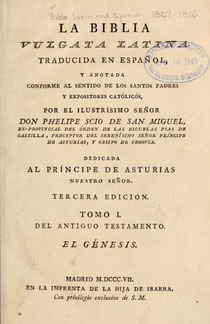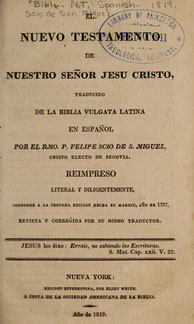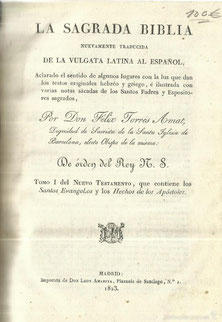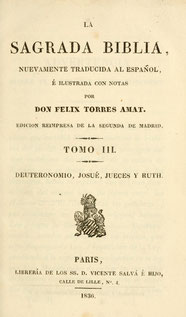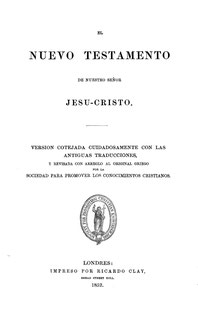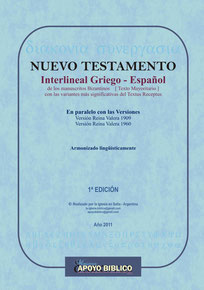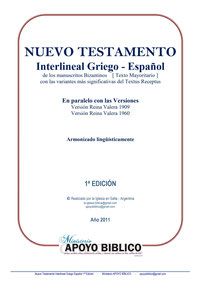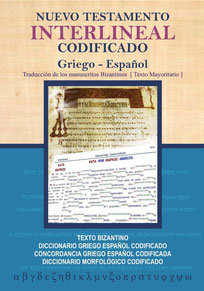SPANISH BIBLES - ONLINE FACSIMILES

The Catholic Church was against its Latin Bible being translated into other languages, as Catholic priests had the sole right to interpret the Bible according to church doctrine. In 1234, the Council of Tarragona decided that all Bibles in the vernacular languages should be burned and people were forbidden to own translations of the Bible. In this way, people were to be kept away from the Word of God. Nevertheless, King Alfonso dared to translate the entire Bible into Spanish in the 13th century. Nevertheless, King Alfonso X dared to translate the entire Bible into Spanish in the 13th century. To this purpose, he set up a school of translators in Toledo, in which not only Christians but also Muslims and Jews were involved, as they had the opportunity to gain access to important writings and had an excellent knowledge of the languages. From the 14th century onwards, Jewish Bible scholars began to translate directly from the Hebrew. At this time, the largest Jewish community in Europe lived in Spain. The term "biblia romanceada" (Wikipedia) is traditionally used in publications, codices and studies as a synonym for "medieval translation of the Bible into Castilian".
In Spain, the persecution of Bible translators was particularly cruel. Therefore the work on the Word of God had to be done abroad. The first Spanish Bibles had to be secretly printed in the
Netherlands and Switzerland and brought to Spain. The Bible smugglers were killed in the most horrific way and most of the books were burned. It is therefore not surprising that the first Spanish
language Bible printed in Spain did not appear until 1790. Until then, only the Latin Vulgate was allowed and the Church took the right
to interpret the Bible alone. As a result, the Christians had no chance to learn anything about the true day of Jesus' resurrection. But as in other languages, the first Spanish Bibles included
the resurrection of Jesus „on a Sabbath“ or „on the first Sabbath“ (see Spanish Bibles show the Resurrection on a Sabbath).
It is possible to download facsimiles of historical online Bibles in PDF format for free. Compared to Germany, the number of Spanish Bibles is significantly lower.
German: Die katholische Kirche war dagegen, dass ihre lateinische Bibel in andere Sprachen übersetzt wurde, da die katholischen Priester das alleinige Recht hatten, die Bibel gemäß der kirchlichen Lehre auszulegen. Im Jahr 1234 beschloss das Konzil von Tarragona, dass alle Bibeln in den Volkssprachen verbrannt werden sollten, und es wurde den Menschen verboten, Bibelübersetzungen zu besitzen. Auf diese Weise sollten die Menschen vom Wort Gottes ferngehalten werden. Dennoch wagte es König Alfonso X. im 13. Jahrhundert, die gesamte Bibel ins Spanische zu übersetzen. Zu diesem Zweck gründete er in Toledo eine Übersetzerschule, an der nicht nur Christen, sondern auch Muslime und Juden beteiligt waren, da sie die Möglichkeit hatten, Zugang zu wichtigen Schriften zu erhalten und über ausgezeichnete Sprachkenntnisse verfügten. Ab dem 14. Jahrhundert begannen jüdische Bibelgelehrte, direkt aus dem Hebräischen zu übersetzten. Zu dieser Zeit lebte in Spanien die größte jüdische Gemeinde Europas. Der Begriff "biblia romanceada" (Wikipedia) wird in Publikationen, Codices und Studien traditionell als Synonym für "mittelalterliche Übersetzung der Bibel ins Kastilische" verwendet. In Spanien war die Verfolgung der Bibelübersetzer besonders grausam. Daher mussten die Arbeiten am Wort Gottes im Ausland verrichtet werden. Die ersten spanischen Bibeln mussten heimlich in den Niederlanden und in der Schweiz gedruckt und nach Spanien gebracht werden. Bibel-Schmuggler wurden auf grausamste Weise getötet und die meisten Bücher wurden verbrannt. Daher überrascht es nicht, dass die erste in Spanien gedruckte spanischsprachige Bibel erst im Jahre 1790 erschien. Bis dahin war nur die lateinische Vulgata zugelassen und die Kirche nahm sich das Recht, allein die Bibel auslegen zu dürfen. Als Folge davon, hatten die Christen keine Chance etwas von dem wahren Tag der Auferstehung Jesu zu erfahren. Aber wie in anderen Sprachen auch, so beinhalteten auch die ersten spanischen Bibeln die Auferstehung Jesu „an einem Sabbat“ oder „am ersten Sabbat“ (siehe das Kapitel Sabbat-Auferstehung in spanischen Bibeln). Es ist möglich, Faksimiles historischer Online-Bibeln im PDF-Format kostenlos herunterzuladen. Im Vergleich zu Deutschland ist die Anzahl der spanischen Bibeln deutlich geringer.
Facsimiles and Online Bibles
Numerous Spanish Bible translations are offered online at the following websites:
Bibliatodo.com, Biblegateway.com, Bible.com, Bibliotheca Digital Hispanica, Orbayu-Biblioteca Protestante
Proyecto Biblia Medieval, List of Spanish Bibles, Wikipedia
Book about the history of the Spanish Bible: Rafael A Serrano (2014): Historia de la Biblia en español (Google Books)
Fazienda de Ultramar 1220-1235
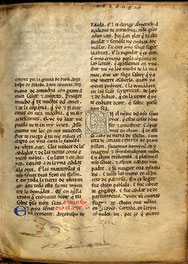
Probably the oldest Bible text in Spanish can be found in La Fazienda de Ultra Mar (Acts of the Apostles from Overseas) from the early 13th century (Wikipedia). This work contains an account of a journey to Israel and includes information from the Pentateuch and other books of the Hebrew Scriptures (Old Testament) as well as from the Gospels and the Epistles. There is one surviving manuscript, which is housed in the library of the University of Salamanca. The codex consists of 86 folios. However, this is not a genuine translation of the Bible, but rather a travel report in which parts of the Bible were also translated or only described.
Facsimiles:
1220 Fazienda, (lafaziendadeultramar), Link2
1220 Fazienda, printed 1965 by editor Moshe Lazar Almerich (Goodreads)
Dave McDougall: The Fazienda de Ultramar and the Contribution of the Vulgate
Biblia Romanceada 14th Century
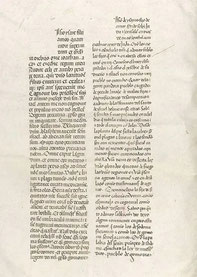
The name "biblia romanceada" (Wikipedia) is a collective term for medieval publications from the 14th century in the "Romanic" language, as Castilian was also called. In general, only parts of the Old Testament were translated. The most important writings or codices are:
1) Biblias romanceadas Codex E4, E5, E6, E7, E8 and E9, found in the Biblioteca de San Lorenzo de El Escorial, Madrid, Spain. The Biblia Prealfonsina, also known as the Biblia Romanceada Prealfonsina (see below), is a translation of the Bible into Spanish, based on the Latin Vulgate and the original languages. It is preserved in two of the aforementioned manuscripts, E6 (I-j-6), from the 13th century, and E8 (I-j-8), from the 15th century, which are complementary. The Biblia de Osuna is preserved in the manuscript I.I.6, see below.
2) Codex 87, which is in the Real Academia de Historia, Madrid, Spain. Latin text and parallel Spanish translation of the books of 1 and 2 Maccabees.
3) Codex 10288, in the Biblioteca Nacional de España, Madrid, Spain.
4) Codex CXXIV/1-2, in the Biblioteca Pública de Évora, Évora, Portugal.
5) Codex 52-XIII-1, held at the Biblioteca de Ajuda. Lisbon, Portugal.
6) The Alba Bible, La Biblia de Alba, (see below), Palacio de Liria, Madrid, Spain, see below.
Biblia Prealfonsina ca 1250
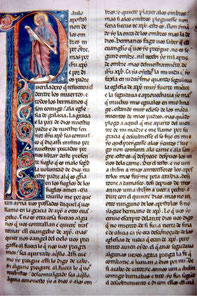
The process of translating biblical texts into Spanish began in the 13th century. The oldest surviving remnants of a translation of the Bible into Castilian are those of the so-called Biblia Prealfonsina (i.e. Bibles that were produced before the Alfonsina Bible 1280), which is kept in the Library of El Escorial (Real Biblioteca del Monasterio de San Lorenzo de El Escorial, Spain).
Manuscript E6 is composed of 358 folios on parchment with the text arranged in two columns, with 28 miniatures. It seems to have been copied close to its date of composition around 1250. The corpus includes the text in its entirety which contains the following books: Proverbs, Ecclesiastes, Song, Wisdom, Ecclesiasticus, Isaiah, Jeremiah, Lamentations, Baruch (which includes the Epistle of Jeremiah), Ezekiel, Daniel (with the Prayer of Azariah, the Hymn of the Three Young Men, the Story of Susanna and the Story of Bel and the Dragon), Twelve Prophets and Maccabees 1-2. It continues with the NT with the following books: the four Gospels, Acts of the Apostles, Epistles of St. Paul, Epistle of St. James the Apostle, Epistles of St. Peter the Apostle, Epistles of St. John, Epistle of St. Jude and Revelation. Manuscript E8 consists of 236 leaves on paper and is laid out in two columns. It was produced around 1400 and contains the OT.
Facsimiles:
Biblia Alfonsina - Alfonso Bible 1280
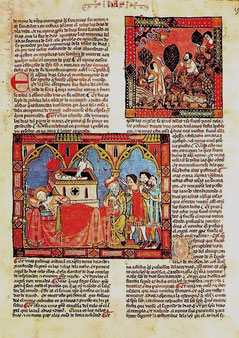
Alfonso X el Sabio (Alfonso the Wise; *1221, †1284; Wikipedia) was King of Castile and Leon and also German Emperor (1257-1273). Because of his commitment to culture and science, he was nicknamed "the wise man" (el sabio). He founded a school of translation in Toledo, which consisted of Christians, Jews and Muslims. Among the work of the experts was the translation of the OT and the Gospel of Luke from the Vulgate. It was thus the first Spanish Bible ever. It was copied by monks and was named "King's Bible" or "Biblia Alfonsina" (Wikipedia) in honor of the king. Wikipedia reports that the Biblia Alfonisa is supposedly „the first translation into a European language“. This is not correct, because by then there were even several German translations and the Gothic Bible from 350-380 AD had already appeared before the Latin Vulgate (382 AD), which was officially approved by the Pope. However, it is one of the first complete publications of the complete Bible (OT) in a modern language. In addition to the Hebrew basic text, phrases were also taken from the latin Vulgate, so that some inaccuracies have occurred. The Bible was published in 1280, but most of the books of the New Testament (with the exception of the Gospel of Luke) have not been translated. The work exists in several versions, as it was constantly revised not only during King Alfonso's lifetime but also after his death.
The biblical text is divided into 6 parts:
- Part 1: Pentateuch
- Part 2: Joshua, Judges, 1 and 2 Samuel, 1 and 2 Kings
- Part 3: Song of Songs, Proverbs, Wisdom, Kohelet, Psalms, Isaiah, Ezekiel, Joel, Hos, Am, Jon, Tobit, Job, 1/2 Chronicles
- Part 4: Jer, Daniel, Obadiah, Zeph, Lament, Baruch, Hab, Judith, Ezra, Neh, Haggai, Zech, Esther and Eccles.
- Part 5: Maccabees 1, Maccabees 2
- Part 6: New Testament (not completely translated, only the Gospel of Luke is available)
In this Catholic manuscript all Christians could find the Sabbath resurrection of Jesus, because the Latin Vulgate has been correctly translated into the Spanish language. The basic Greek text, the Latin Vulgate and the first Spanish Gospel do not differ in their statements (example).
Facsimiles, online PDF download:
1280 Biblia Alfonsina, Scribd.com
1280 Biblia Alfonsina, Iglesiareformada.com, Part 2
1280 Biblia Alfonsina, Online-Text, TheWord.net PC Program Modul (Downloads, Module Library), Extra Module
German: Alfons der Weise (Alfonso X el Sabio; *1221, †1284; Wikipedia) war König von Kastilien und León und zugleich auch Deutscher Kaiser (1257–1273). Aufgrund seines Engagements für die Kultur und Wissenschaft, erhielt er den Beinamen „der Weise“ (el sabio). Er gründete in Toledo eine Übersetzerschule, die aus Christen, Juden und Moslems bestand. Zu den Arbeiten der Experten gehörte auch die Übersetzung des AT und des Lukasevangeliums aus der Vulgata. Es war damit die erste spanische Bibel überhaupt. Sie wurde von Mönchen abgeschrieben und erhielt zu Ehren des Königs den Namen „Königs-Bibel“ oder „Biblia Alfonsina“. In Wikipedia wird berichtet, dass die Biblia Alfonisa angeblich „die erste Übersetzung in eine europäische Sprache“ sei. Das ist nicht korrekt, denn bis dahin gab es sogar mehrere deutsche Übersetzungen und die gotische Bibel von 350-380 n. Chr. erschien bereits vor der lateinischen Vulgata (382 n. Chr.), die vom Papst offiziell genehmigt wurde. Allerdings ist es eine der ersten vollständigen Veröffentlichungen der Bibel in einer modernen Sprache. Neben dem hebräischen Grundtext wurden auch Sätze aus der lateinischen Vulgata übernommen, so dass es zu einigen Ungenauigkeiten gekommen ist. Die Bibel wurde 1280 veröffentlicht, aber die meisten Bücher des Neuen Testaments (mit Ausnahme des Lukasevangeliums) wurden nicht übersetzt. Das Werk existiert in mehreren Fassungen, da es nicht nur zu Lebzeiten König Alfonsos, sondern auch nach seinem Tod ständig überarbeitet wurde. Der biblische Text ist in 6 Teile gegliedert:
- Teil 1: Pentateuch
- Teil 2: Josua, Richter, 1 und 2 Samuel, 1 und 2 Könige
- Teil 3: Hohelied, Sprüche, Weisheit, Kohelet, Psalmen, Jesaja, Hesekiel, Joel, Hosea, Amos, Jona, Tobit, Hiob, 1 und 2 Chronik
- Teil 4: Jeremia, Daniel, Obadja, Zephanja, Klagelieder, Baruch, Hab, Judith, Esra, Neh, Hag, Sach, Esther und Eccl.
- Teil 5: Makkabäer 1, Makkabäer 2
- Teil 6: Neues Testament
In dieser katholischen Handschrift konnten alle Christen die Sabbat-Auferstehung Jesu finden, denn die lateinische Vulgata ist korrekt in die spanische Sprache übertragen worden. Der griechische Grundtext, die lateinische Vulgata und das erste spanische Evangelium unterscheiden sich in ihren Aussagen nicht (Beispiel).
Biblia de Alba - Alba Bible - Biblia de Arragel 1422-1431
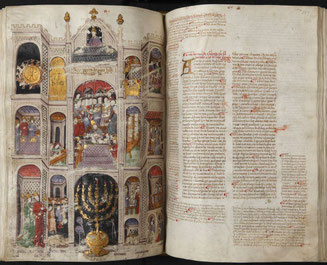
The Alba Bible (Wikipedia) is a illuminated manuscript translation of the Old Testament made directly from Hebrew into Medieval Castilian. It was carried out under the direction of Rabí Mošé Arragel (Moses Arragel de Guadalfajara; †1493; Wikipedia), rabbi of the Jewish community of Maqueda in the Spanish province of Toledo. The Alba Bible 1430 contains three illustrations of the Menorah (seven-branched lampstand; see Menorah). The Bible was published for the public by the Duke of Berwick and de Alba between 1920 and 1922.
Title 1920: „Biblia / Antiguo Testamento / Traducida del hebreo al castellano por Rabí Mose Arragel de Guadalfajara (1422 1433?) y publicada por el Duque de Berwick y de Alba“
Facsimiles, online PDF download:
1430 Biblia de Alba, reprint 1920 (Biblioteca Digital Hispanica, r/805), Link2
1430 Biblia de Alba, Wikipedia
1920-22 Biblia de Alba, Rabí Mose Arragel, Madrid by Imprenta Artística. (Biblioteca Digital Hispánica, r/805)
German: Die Alba-Bibel (Wikipedia) ist eine illuminierte Handschrift-Übersetzung des Alten Testaments, die direkt aus dem Hebräischen ins Mittelalterliche Kastilische (Spanische) übersetzt wurde. Sie wurde unter der Leitung von Rabbi Moses Arragel (Moses Arragel de Guadalfajara; †1493; Wikipedia), Rabbiner der jüdischen Gemeinde Maqueda in der spanischen Provinz Toledo, hergestellt. Die Alba-Bibel 1430 beinhaltet drei Menora Abbildungen. Die Bibel wurde vom Herzog von Berwick und de Alba zwischen 1920 und 1922 für die Öffentlichkeit herausgegeben.
La Biblia del Marqués de Santillana - Martín de Lucena 1450
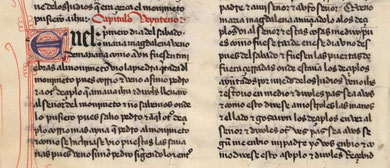
The Bible of the Marquis of Santillana (Íñigo López de Mendoza; *1398; †1458; Wikipedia) is preserved in fragments in two codices (BNE MSS/10288 with the later prophets and some writings, and BNE MSS/9556 with the Gospels and the Epistles of Paul), which must have been accompanied by a first volume that is not preserved with the rest of the Bible (Biblia Romanceada del Marqués de Santillana). This work was commissioned by de Mendoza, who was the baptismal godfather of the translator Martín de Lucena, a Jewish convert, who translated the Bible from Hebrew and Latin.
Title: „Los Santos Evangelios en romance / los cuales son romançados por el Reverendo Doctor Maestre Martín de Lucena, el Macabeo, por mandado del Excellentíssimo Caballero Iñigo López de Mendoza (h.1 67v). Epístolas de San Pablo en romance/ las cuales son romançadas por el Reverendo Doctor Maestre Martín de Lucena, el Macabeo, por mandado del Excellentíssimo Caballero Iñigo López de Mendoza (h. 68 97)“
Facsimiles:
1450 Lucena (Biblioteca Digital Hispánica, MSS/9556), Link2
Info: La Biblia completa del Marqués de Santillana, PDF (revistadefilologiaespañola)
Espistolas y Evangelios by Gonzalo García de Santa María 1484
The first printed edition of a part of the Bible in Castilian was published in Zaragoza (Kingdom
of Aragon) by Gonzalo García de Santa María (*1447; †1521; Wikipedia). These were not exact translations of the Bible, but rather excerpts that were to be read aloud on certain
days during the church year. The aim was to spread Catholic Church teachings. There were several places of printing such as Zaragoza (1485, 1491, 1494 and 1499), Salamanca (1493), Alcalá (1526)
and Toledo (1548).
Title 1484: „Los Evangelios e epístolas de todo el anyo con sus exposiciones en romance, versión del texto de Guillermus Parisiensis (Zaragoza, 1485)“ (?)
Title 1908: „Evangelios e epistolas con sus exposiciones en romance; segun la version castellana del siglo XV, hecha por Gonvalo Garcia de Santa Maria del texto de Guillermus Parisiensis: Postilla super epistolas et evangelia...“
Facsimiles:
Info: Margherita Morreale: Los Evangelios y Epístolas de Gonzalo García de Santa María y las Biblias romanceadas de la Edad Media, Universidad Católica de Washington, PDF (ifc.dpz.es)
Epistles and Gospels of the year by Fray Ambrosio de Montesino 1512
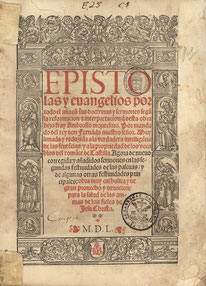
Lectionarium missae: Espístolas y Evangelios del año by Fray Ambrosio de Montesino (*1444?-29; †1514; Wikipedia). Translation of the readings of the Roman Missal based on the version of Gonzalo Garcia de Santa Maria at the request of the Catholic kings. (Antwerp, Habsburg Netherlands and Barcelona, Spain). It was later revised by Román de Vallzillo in 1586. These kinds of books were not about translating the NT correctly, but about reading Catholic Church teachings over the course of the year. These writings are useless for Bible study because the text was often not translated correctly, as the main purpose was to spread Catholic doctrine throughout the year. Therefore, non-biblical words such as Sunday, the feast of the Conception of the Virgin Mary, the veneration of the saints, the Trinity and Catholic feast days were frequently mentioned.
Print locations: Toledo (1512, 1532, 1535, 1549), Sevilla: Juan Varela 1526, Sevilla: Juan Cromberger 1536, Sevilla 1543, Amberes (Antwerp; 1538, 1542, 1544, 1550, 1558), Zaragoza (1550, 1555) etc.
Title: „Epístolas y Evangelios por todo el año con sus doctrinas y sermones“
Facsimiles:
1537 Montesino, Seuilla: por Iuā crōberger (BdH, R/1285), Link2
1550 Montesino, En çaragoça: por Bartholome de Nagera (BdH, U/3849), Link2
1550 Montesino, (BdH, RES. 1003 V.), Link2, PDF, Link3
1558 Montesino, En Anuers : en casa de Iuan Steelsio (typis Ioannis Latij) (BdH, U/1555)
Complutensian Polyglot Bible 1514-1520 and Biblia Regia 1568-1573
There were several important Spanish Polyglot Bibles, but the Spanish language was not included in them because it was forbidden by the catholic church. See Polyglot Bibles
NT by Juan de Valdés 1529
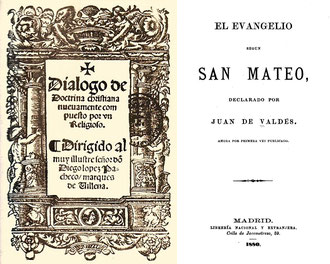
The first Protestant translation of parts of the Bible into Spanish by Juan de Valdés (*1494/1504; †1541; Wikipedia). It includes the Spanish translation of the Sermon on the Mount, chapters 5 to 7 of the Gospel of Matthew. The prohibition of the book by the Spanish Inquisition led him to go into exile in Italy, with the support of Charles V. In Naples he continued translating books of the Bible: Book of Psalms, the complete Gospel of Matthew (1535/36), Epistle to the Romans (1556) and First Epistle to the Corinthians (1557). He was considered a genius in classical languages such as Greek, Hebrew and Latin.
Title: „Diálogo de Doctrina Cristiana, published without indication of author in the printing house of Miguel de Eguía.“
Title Matthew Gospel 1535: „El Evangelio según San Mateo“
Title 1856: „La epistola de San Pablo á los Romanos i la I a los Corintios [Texto impreso] / ambas traduzidas i comentadas por Juan de Valdés“
Title 1882: English: „Juán de Valdés' commentary upon the Gospel of st. Matthew. Now for the first time translated from the Spanish, and never before published in English by John T. Betts, London: Tübner & Co“ - Note: Here the Spanish text is translated incorrectly into English in several places, especially in those that speak of the day of Jesus' resurrection (un sábado = a Sabbath) and not „on the first day of the week“ (el primer día de la semana). More Info.
Facsimiles and Online Text:
1529 de Valdés, Diálogo de Doctrina Cristiana (ellibrototal)
1535 de Valdés, El evangelio según San Mateo, PDF of 2003 as modern text (biblioteca.org.ar)
1535 de Valdés, El evangelio según San Mateo, Online Text (cervantesvirtual)
1535 de Valdés, El evangelio según San Mateo, Online Text (biblioteca-antologica), PDF
1535 de Valdés, El evangelio según San Mateo (ellibrototal)
1535 de Valdés, Diálogo de Doctrina Cristiana (ellibrototal)
1856 de Valdés, Romanos / Corintios, Reprint from 1556 (BdH, U/9740), Link2
1856 La Epistola de san Pablo a los Romanos/1Corintios (Archive), Link2
1880 de Valdés, San Mateo, Madrid: Librería Nacional y Extranjera, Eduardo Boehmer (GB), Link2
1882 John T. Betts, English Translation of Valdes/Matthew (GB), Romans, 1Corinthians, 1Corinthians-b
1883 John T. Betts, English, Commentary Romans/1Cor, London: Trübner (Archive), Link2
1964 Diálogo de doctrina christiana, Reprint, Mexico (Archive), Link2
Francisco de Enzinas NT 1543

The first complete NT in Spanish was translated by the later Protestant Francisco de Enzinas (=Franciscus Dryander, *1518, †1552; Wikipedia) and printed in the Netherlands (Antwerp, Ambres) by Steven Mierdman (Stephan Mierdman; *c.1510; †1559; Wikipedia). Enzinas was a very good connoisseur of the Greek language and worked as professor of Greek at the University of Cambridge in 1548/49. At the instigation of the Spanish Catholic Church, which only allowed the Latin Vulgate, printing was banned and all Spanish Bibles (except for a few copies) were completely destroyed. Enzina's translation has been highly praised, and quite rightly so, because he was able to reproduce the meaning exactly in Spanish. In his Bible, Jesus rose from the dead on a Sabbath morning (see Link).
Title 1543: „El Nuevo Testamento de nuestro Redemptor y Salvador Jesu Christo, traduzido de Griego en lengua Castellana, por Francisco de Enzinas, dedicado a la Casera Magestad.
Habla Dios. Josue: No se aparte el libro de esta ley de tu boca. Antes con atento animo estudiaras en el día y de noche: para que guardes y hagas conforme a todo aquello que esta en el escrito. Por que entonzes haras prospero. Por que entonzes haras prospero tu camino, y te gobernaras con prudencia. 1543"
Facsimiles, online PDF download (Nuevo Testamento de Francisco de Enzinas):
1543 Enzinas-NT, Enueres : en casa de Esteuan Mierdmanno (BDH, Signatura: U/8477), Link2
1543 Enzinas-NT, Antwerpen, Belgien, Nuevo Testamento traducido por Francisco de Enzinas (Archieve)
1543 Enzinas-NT, Enueres: en casa de Esteuan Mierdmanno, Microfiche (WLB Stuttgart)
1543 Enzinas-NT, Enueres: en casa de Esteuan Mierdmanno (WLB Stuttgart, Signatur: B span.154301)
1543 Enzinas-NT, Antwerp: Esteuan Mierdmanno (Christies)
German: Das erste vollständige NT in spanischer Sprache wurde von dem späteren Protestanten Francisco de Enzinas (=Franciscus Dryander, *1518, †1552; Wikipedia) übersetzt und in den Niederlanden (Antwerpen) durch Stephan Mierdman (*ca.1510; †1559; Wikipedia) gedruckt. Enzinas war ein sehr guter Kenner der griechischen Sprache und arbeitete 1548/49 als Professor für Griechisch an der Universität Cambridge. Auf Veranlassung der spanischen katholischen Kirche, die nur die lateinische Vulgata erlaubt hat, wurde der Druck verboten und alle spanischen Bibeln (mit Ausnahme weniger Exemplare) wurden komplett vernichtet. Die Übersetzung Enzinas ist sehr gelobt worden und das völlig zu Recht, denn er konnte den Sinn ins Spanische exakt wiedergeben. In seiner Bibel ist Jesus an einem Sabbat-Morgen auferstanden (siehe Link).
Ferrara Bible - Biblia de Ferrara - Biblia Ladino 1553
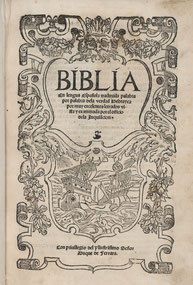
This edition of the Hebrew Bible in Spanish, known as the Ferrara Bible, was intended mainly for Jews who had been driven from Spain in 1492. The Old Testament (Tanakh) has been published in Ladino (Judeo-Spanish), a Romance language spoken by Sephardic Jews since the Middle Ages and sometimes called "Sephardic" (from the Hebrew sefarad: Iberia) after them. Casiodoro de Reina additionally used this print for his translation (Reina-Valera Bible). The Sephardic Jews of Spanish origin published this edition in the Italian city of Ferrara in the workshop of Abraham Usque (Christian name: Duarte Pinhel; *c. 1520; †1558; Wikipedia), a Jew from Portugal, printer and publisher in Ferrara, Italy.
Title 1553 [5313]: „Biblia en Lengua Española Traducida Palabra por Palabra de la Verdad Hebrayca por Muy Excelentes Letrados, Vista y Examinada por el Oficio de la Inquisicion. Con Privilegio del Ylustrissimo Señor Duque de Ferrara.“
Title 1661 [5421]: „Biblia en lengua española / Traducida palabra por palabra de la verdad hebrayca, por muy excelentes letrados. Vista y examinada por el Officio de la Inquisicion. Con Privilegio del Ilustrissimo Señor Duque de Ferrara.“
Title 1762 [5486]: Bible in two columns, Hebrew-Spanish: „Torah Neviʼim u Khetuvim bi shne ʻamudim = Biblia en dos colunas Hebrayco y Español ... en la primera ... el original hebraico ... en la segunda ... la traduccion en la lengua española / [por Abraham Mendez de Castro].“
Facsimiles, online PDF download of the Ferrara Bible:
1553 Biblia de Ferrara (Archive)
1553 Biblia de Ferrara, Ferrara: A costa de Jeronimo de Vargas (ÖNB), Link2
1553 Biblia de Ferrara, Publisher: Jeronimo de Vargas (Ferrara) (Bibliothèque nationale de France)
1553 Biblia de Ferrara, Wikipedia
1553 Biblia de Ferrara, Biblioteca Virtual de Polígrafos (larramendi)
1553 Biblia de Ferrera, En Amsterdam: Ioseph Athias y por su ordĕ Impressa (Bibliotheca Sefarad)
1553 Biblia de Ferrara (Biblioteca Nacional de Portugal), Link2
1553 Biblia de Ferrara, (Europaea)
1553 Biblia de Ferrara, (booktryst)
1611 Biblia de Ferrera, En Amsterdam: [s.n.] (BdH, Biblioteca Digital Hispánica, U/775), Link2
1630 Biblia de Ferrara, (BdH, Biblioteca Digital Hispánica, U/8549), Link2
1661 Biblia de Ferrara, (Archive)
1661 Biblia de Ferrara, (Bibliotheka Sefarad)
1726 Biblia de Ferrera, Amsterdam: imprimida por David Fernandes (BdH, U/5219), Link2
1726 Biblia De Ferrara, Amsterdam printing (Archive)
1762 Biblia Hebrayco-Espanol, Amsterdam: Joseph, Iacob, y Abraham de Salomon Proops (BDH, U/8895), Link2
German: Diese Ausgabe der hebräischen Bibel in spanischer Sprache, bekannt als Ferrara-Bibel, war hauptsächlich für die 1492 aus Spanien vertriebenen Juden bestimmt. Das Alte Testament (Tanach) wurde in Ladino (Judenspanisch) veröffentlicht, einer romanischen Sprache, die von den sephardischen Juden seit dem Mittelalter gesprochen und nach ihnen manchmal "sephardisch" (vom hebräischen sefarad: Iberia) genannt wird. Casiodoro de Reina verwendete diesen Druck auch für seine Übersetzung (Reina-Valera-Bibel). Die sephardischen Juden spanischer Herkunft veröffentlichten diese Ausgabe in der italienischen Stadt Ferrara in der Werkstatt von Abraham Usque (Vorname: Duarte Pinhel; *um 1520; †1558; Wikipedia), einem Juden aus Portugal, Drucker und Verleger in Ferrara, Italien.
Nuevo Testamento de Juan Pérez de Pineda 1556
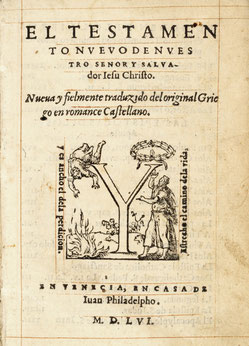
Juan Pérez de Pineda (*1490, †1567; Wikipedia) was one of the most important Spanish reformers. Together with Jean Crespin (=Iuan Philadelpho; *1520, †1572, Wikipedia) he improved the NT of Enzina in a more fluent language and had it printed in Geneva in 1556. In order to conceal the actual place of printing (Geneva was considered Protestant) and to be able to distribute the Bible in Spain, the title page indicated Venecia (Venice, Italy), the headquarters of the Catholic Church (Rome), as the place of manufacture. Several of these Bibles have also been smuggled into Spain. The Württembergische Landesbibliothek (WLB, Germany) has one copy in its collection for insight. A free copy is also available for download from Google Books. In 1558 the number of Protestant refugees in Geneva was so great that a separate Spanish church was founded. The Spanish Bible always spoke of the resurrection of Jesus on a Sabbath morning (see examples).
Title 1556: „El Testamento nuevo de nuestro señor y salvador Iesu Christo. Nueva y fielmente traduzido del original Griego en romance Castellano. En Venecia, en casa de Iuan Philadelpho. 1556.“
Facsimiles, online PDF download:
1556 Pineda-NT, Genf, Nuevo Testamento editado por Juan Pérez de Pineda (Archive)
1556 Pineda-NT, Venecia [i.e. Geneva] : en casa de Iuan Philadelpho (WLB Stuttgart), Link2
1556 Pineda-NT, Venise [Genève] : [Jean Crespin] « Juan Philadelpho » (ERARA), Link2
1556 Pineda-NT, Venecia [i.e. Ginebra] : en casa de Iuan Philadelpho [i.e. Jean Crespin] (BDH, Signatura U/7620), Link2
1556 Pineda NT, Iuan Philadelpho (Bridwell Library)
1557 Pineda Psalmen, Los Psalmos de David con sus sumarios, printed in Venecia (Numelyo, Cote : 327567)
German: Juan Pérez de Pineda (*1490, †1567; Wikipedia) war einer der bedeutendsten spanischen Reformatoren. Zusammen mit Jean Crespin (=Iuan Philadelpho; *1520, †1572, Wikipedia) verbesserte er das NT von Enzina in einer flüssigeren Sprache und ließ es 1556 in Genf drucken. Um den tatsächlichen Druckort zu verheimlichen (Genf galt als protestantisch) und um die Bibel in Spanien verbreiten zu können, wurde auf dem Titelblatt als Herstellungsort Venecia (Venedig, Italien), dem Hauptsitz der katholischen Kirche (Rom) angegeben. Mehrere dieser Bibeln sind auch nach Spanien geschmuggelt worden. Die Württembergische Landesbibliothek (WLB) hat ein Exemplar in ihrem Bestand zur Einsicht. Auch bei Google-Books gibt es eine kostenlose Kopie zum Download. Im Jahr 1558 war die Zahl der protestantischen Flüchtlinge in Genf so groß, dass eine eigene spanische Kirche gegründet wurde. In dieser spanischen Bibel war stets von der Auferstehung Jesu an einem Sabbat-Morgen die Rede (siehe Beispiele).
Bear Bible (Biblia del Oso), Biblia de Casiodoro de Reina 1567 / 1569

The first complete Spanish Bible. Casiodoro de Reina (*1525, †1594; Wikipedia) was a catholic monk from Spain. He was a great connoisseur of the original biblical languages. However, when he came into contact with the Reformation, he was classified as a heretic by the Church and had to flee from the Spanish Inquisition to England, Germany and later to Switzerland. In Switzerland he translated the entire Bible from the original languages and had it printed in Basel in 1569. He thus published the first complete Spanish Bible, which was published 42 years before the English King James Bible (KJV 1611). It was nicknamed "Bible of the Bear" (La Biblia del Oso) because the title page of the Bavarian (German) printer Mattias Apiarius had a bear on it. For the NT, which was published as early as 1567, he had the Greek Textus Receptus (Stephen's 1550 edition) as a textual basis. Although neither the translator nor the place of printing was mentioned in the 1569 print, the Inquisition nevertheless learned in 1571 that the place of printing was Basel and had most of the Bibles burned. There were also reprints in other places, for example in London (Field) in 1596. Since Reina could not be arrested, his picture was publicly burned in Seville and all his books were banned. In 1622 the same text was reprinted in Germany (Frankfurt/Main) by Daniel and David Aubrij (Aubrey, Aubrey Bible). But the title page was different and contained a horse (see below).
Title 1569: „La Biblia que es, los Sacros Libros del Vieio y Nuevo Testamento. Trasladada en Español. La Palabra de Dios nuestro permanece para siempre. Isa.40. 1569“
Facsimiles, online PDF download:
1569 Biblia del Oso (Bibles Online.net)
1569 Biblia del Oso, Basel: Samuel Apiarius für Thomas Guarin (ERARA, VD16 B 2869)
1569 Biblia del Oso, Basel: Samuel Apiarius für Thomas Guarin (ERARA, VD16 B 2869)
1569 Biblia del Oso, Basel. Casiodoro de Reina (Archive), Open Library
1569 Biblia del Oso, Basel, Biblia protestante (Archive), Link2
1569 Biblia del Oso, Basel, Spanish Bear Bible (Archive)
1569 Biblia del Oso, Basel, Biblia Del Oso (Archive)
1569 Biblia del Oso, Basel, Biblia de Casiodoro de Reina (Archive)
1569 Biblia del Oso, Basel, Cassiodoro de Reina (Archive)
1569 Biblia del Oso, Basel: T. Guarinus (Archive)
1569 Biblia del Oso, [Basel]: [Samuel Apiarius and Thomas Guarinus] (Archive)
1569 Biblia del Oso, Basel, Cassiodoro de Reina (AD076, Archive)
1569 Biblia del Oso, Basilea: Thomas Guarin (WebArchive)
1569 Biblia del Oso, Basliea (memoriademadrid), Biblioteca Histórica
1569 Biblia del Oso, Basel, Online-Text, Bibliatodo.com
1569 Biblia del Oso, Wikipedia
1569 Biblia del Oso, Online-Text (Biblestudytools.com)
1569 Biblia del Oso, Suiza, Basilea, Guarin, Thomas, impresor (repositorioinstitucional)
1622 Biblia del Oso, Basel (BNE, Signatura U/3474), Link2
1622 Biblia del Oso, Basel (Archive)
1622 Biblia del Oso, Basel (Archive)
1622 Biblia del Oso, John Carter Brown Library (Archive)
Reprint in Frankfurt, but no longer with the bear, but with a horse on the title page:
1622 Biblia del Oso, Frankfurt, En la Libreria de Daniel y David Aubrij y de Clement Schleich (liburutegibiltegi), PDF
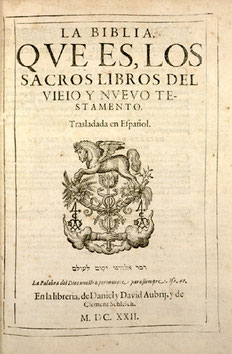
German: Die erste spanische Voll-Bibel. Casiodoro de Reina (*1525, †1594; Wikipedia) war ein katholischer Mönch aus Spanien. Er war ein großer Kenner der biblischen Originalsprachen. Als er jedoch mit der Reformation in Verbindung kam, wurde er von der Kirche als Ketzer eingestuft und musste vor der spanischen Inquisition nach England, Deutschland und später in die Schweiz fliehen. In der Schweiz übersetzte er die gesamte Bibel aus den Original-Sprachen und ließ sie 1569 in Basel drucken. Er veröffentlichte damit die erste vollständige spanische Bibel, die bereits 42 Jahre vor der englischen King James Bibel (KJV 1611) erschienen ist. Sie erhielt den Spitznamen „Bibel des Bären“ (La Biblia del Oso), weil auf dem Titelblatt des bayerischen Drucker Mattias Apiarius ein Bär abgebildet war. Für das NT, welches bereits 1567 veröffentlicht wurde, stand ihm als Textgrundlage der griechische Textus Receptus (Stephanus' 1550) zur Verfügung. Obwohl im Druck von 1569 weder der Übersetzer noch der Druckort genannt wurden, erfuhr die Inquisition dennoch im Jahr 1571, dass der Druckort Basel war und ließ die meisten Bibeln verbrennen. Es gab auch an anderen Orten Nachdrucke, z.B. 1596 in London (Field). Da Reina nicht festgenommen werden konnte, wurde sein Bild in Sevilla öffentlich verbrannt und alle seine Bücher wurden verboten. Im Jahr 1622 wurde der gleiche Text in Deutschland (Frankfurt) von Daniel und David Aubrij (Aubrey, Aubrey-Bibel) nachgedruckt (Pferd-Motiv).
Sagradas Escrituras 1569, Reina Valera 2000 and Spanish Jubilee Bible 2000
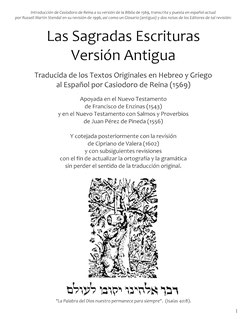
Under the title "Las Sagradas Escrituras Version Antigua" (SE) Russell Martin Stendal published in 1996 a translation of the Reina Bible 1569 with a text comparison of Enzinas-1543 and Pérez de Pineda 1556 in modern Spanish. Other names of the newly published Bible are Reina Valera 2000 (RV2000) and Spanish Jubilee Bible 2000 (Biblia del Jubileo, JBS2000; c.f. English Jubliee Bible JB2000 and EJ2000). The textual differences between these versions are very small.
Facsimiles, online PDF download:
1569 Sagradas Escrituras, Stendal (Project Gutenberg)
1569 Sagradas Escrituras (BibliaParalela.com)
1569 Sagradas Escrituras, SE, online text (Studybible.info)
1999 Las 1569 Sagradas Escrituras. Revised 1999, Online Text (Gratis.Bible)
2000 JBS2000, Biblia del Jubileo, Online Text (biblegateway)
2000 JBS2000, Spanish Jubilee 2000 Bible, Online Text (Studybible)
2000 JB2000, English Jubilee 2000 Bible, Online Text, SWORD-Module
2000 EJ2000, English Jubilee Bible, Online Text (Studybible)
2000 RV2000, Online Text (bibliatodo)
German: Unter der Titel „Las Sagradas Escrituras Version Antigua“ hat Russell Martin Stendal 1996 eine Übersetzung der Reina-Bibel 1569 mit einem Textvergleich von Enzinas-1543 und Pérez de Pineda 1556 in heutigem Spanisch veröffentlicht. Weitere Namen der Bibel sind Reina Valera 2000 (RV2000) und Biblia del Jubileo (Jubilee Bible Spanish JBS; vgl. dazu die englische Jubliee Bible JB2000 bzw. EJ2000). Die textlichen Unterschiede zwischen diesen Versionen sind sehr gering.
Reina Valera 1596 (NT) and Bible 1602 (Biblia del Cántaro)

The Reina Valera Bible (abbreviation: RV) is the best known and worldwide most widespread Spanish Bible translation. It appeared over 40 years before the English King James Bible, which was not printed until 1611. The catholic monk Cipriano de Valera (*1532, †1602; Wikipedia) was a friend of Casiodoro de Reina (*c 1520; †1594; Wikipedia). Because of protestant views, Valera also had to flee from Spain to England. There he worked on the revision of the Bible of Reina. The NT was printed in London in 1596 (the title page shows a sword), the whole Bible in Amsterdam in 1602. The Bible was thus translated by C. de Reyna and revised by C. de Valera, it is therefore called the Reina Valera Bible (RV).
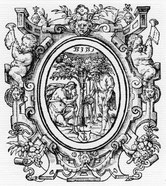
This version no longer contains the image of a bear on the title page, but rather that of a jug (Biblia del Cántaro = Bible of the Jug) from which water flows and waters a tree. The text hardly differs from the Reina Bible of 1569, and both the resurrection of Jesus and the church meeting take place on the first of the seven Sabbaths until Pentecost (see verses). In the later revisions of the RV in the years 1831, 1865, 1909, 1960, 1995 and 2000, the Sabbath was increasingly replaced by the "first day of the week". However, Bibles with the original translation of 1602 were also printed again and again, such as the 1858 editions published in London. Version revistay confrontada con el texto Griego, y con diversas traducciones, por Cipriano de Valera. Londres. 1865") or of 1867, all of which clearly speak of the resurrection of Jesus on the Sabbath.
The sometimes used name "Reina-Valera-Antigua" is a misleading term, since some Christians use it to refer to the first Reina Bible of 1569, while others refer to that version of 1602, and still others use it to refer to later revised versions where the language was updated and the Sabbath was replaced by „el primer día de la semana“ (the first day of the week). Most of today's Bible programs use these revised texts, although they incorrectly cite "Reina-Valera-1602" as the source. However, if you open the original Bibles of 1602 and reprints of 1625 (Amsterdam) and especially the one of 1867 (London), which is more than 260 years later, you will find the resurrection of Jesus on the Sabbath (see Link).
Title 1596 NT: „El Testamento Nuevo de Nuestro Señor Iesu Christo, Luc. 2.10. Heaqui os doy nuevas de gran gozo, que sera a todo el pueblo. En casa de Ricardo Campo. 1596.“
Title 1602: „La Biblia que es, los sacros libros del Vieio y Nuevo Testamento / Segunda Edition. Y conferida con los Textos Hebreos y Griegos y con diversas translasiones. Por Cipriano de Valera 1602.“
Title 1625 NT: „El Nuevo Testamento: que es los Escriptos Evangelicos y Apostolicos. Revisto y Conferido con el texto Griego por Cypriano de Valera. En Amsterdam : En casa de Henrico Lorençi. 1625.“
Title 1850 NT: „El Nuevo Testamento, Traducido al Castellano por Cipriano de Valera en 1602, y revisado en 1831. Nueva York: 1850.“
Title 1858 NT: „EL NUEVO TESTAMENTO DE NUESTRO SEÑOR JESU CRISTO, Ó SEAN LOS ESCRITOS EVANGÉLICOS Y APOSTÓLICOS. Version revistay confrontada con el texto Griego, y con diversas traducciones, por Cipriano de Valera. Londres. 1865.“
Title 1865: „El Testamento Nuevo de Nuestro Señor Iesu Christo, o sean Los escritos evangélicos y apostólicos, Version revista y confrontada con el texto Griego, y con diversas Traducciones, por Cipriano de Valera. Londres, 1865.“
Title 1867: „La Biblia: Que es los sacros libros del viejo y nuevo Testamento, Version revista y confrontada con los textos hebreos y griegos, y con diversas traducciones, por Cipriano de Valera.“
Facsimiles, online PDF download:
List of Bibles that include the Resurrection Sabbath „el primero de los sábados“ (on the first of the Sabbaths), which is according to God's biblical Calendar the 1st Sabbath of the 7 Sabbaths from Passover (Nisan 15) until Pentecost:
1596 RV, NT, Londres: en casa de Ricardo del Campo (BNE, Signatura U/8879), Link2
1596 RV, NT, Londres: En casa de Ricardo del Campo (Biblioteca Histórica Municipal; Memoria de Madrid), Link2, PDF
1596 RV, NT, London: En casa de Ricardo del Campo (British Library, Digital Store 1005.b.12.), Link2 Google Books
1596 RV, NT, London: En casa de Ricardo del Campo, 1596 [16], 742 p. ; 8º BHM (Europanea)
1602 RV, Amsterdam (Bayerische Staats-Bibliothek, BSB, 2 B.lat.f. 42 a), Google Books
1602 RV, Amsterdam: Lorenço Iacobi (Biblioteca Digital Hispánica, U/3212), Link2
1602 RV, Amsterdam: En casa de L. Iacobi (Archive)
1602 RV NT, Amsterdam, en casa de Lorenc o Jacobi (Archive)
1602 RV, En Amsterdam: En Casa de Lorenço Iacobi (liburutegibiltegi.bizkaia)
1602 RV NT, Amsterdam, Online Text (Project Gutenberg, Archive)
1602 RV, Amsterdam en casa de Lorenço Iacobi (Archive), Link2
1602 RV, Amsterdam, en casa de Lorenc o Jacobi (Google Books)
1602 RV, Biblia del Cántaro (Wikipedia)
1602 RV, La Biblia Del Cantaro (Archive), Link2, Link3
1602 RV, 1602 RV, Amsterdam en casa de Lorenço Iacobi (Archive)
1602 RV, Amsterdam en casa de Lorenço Iacobi (Google Books)
1602 RV, Amsterdam en casa de Lorenço Iacobi (Google Books)
1602 RV, Amsterdam en casa de Lorenço Iacobi (Google Books)
1602 RV, Amsterdam en casa de Lorenço Iacobi (Google Books)
1602 RV, Amsterdam en casa de Lorenço Iacobi (Google Books)
1602 RV, Amsterdam en casa de Lorenc o Jacobi (Google Books)
1602 RV, Amsterdam en casa de Lorenc o Jacobi (Google Books)
1602 RV, Online Text (Valara1909.com)
1625 Valera NT, En Amsterdam : en casa de Henrico Lorençi (BDH, Signatura U/10859), Link2
1832 Valera NT, Londres: Sociedad de la Biblia de Glasgow (BDH, Signatura U/3532), Link2
1845 Valera NT, Nueva York: Societa Americana de la Biblia (BDH, Signatura U/4212), Link2
1849 Valera NT, Glasgow: W.G. Blackie & Co. para la Sociedad dela Biblia de Glasgow (BDH, U/10169), Link2
1850 RV, New York (Google Books)
1858 RV, Online Text, London, Sociedad Bíblica Británica y Extranjera (SBBE) (Valera1909.com)
1858 RV, Online Text, London, Gutenberg E-Book (Archieve), Link2
1860 Valera NT, Evangelio de Juan, Madrid Estabablecimiento Tipográfico de Jaime Ratés (BDH, VC/2680/4), Link2
1861 Valera Bibel, Londres: Printed by W. Clowes and Sons (Biblioteca Digital Hispánica, U/6767), Link2
1865 RV, Londres: Spottiswoode y Compania (British Library, Digital Store 3025.e.4.), Google Books
1867 RV, Londres: imprenta de Clowes é Hijos (Google Books)
1867 RV, London: imprenta de Clowes é Hijos, Hijos (Babel Hathitrust)
Revised Bibles that postpone the resurrection of Jesus to Sunday: „en el primer día de la semana“ (1st day of the week):
1816 RV revised, Buenos Aires : Sociedad Bíblica Americana (Archive)
1861-1862 RV revised, Oxford : Imp. de la Universidad (BDH, Signatura U/499), Link2
1862 RV revised, Oxford: Imp. de la Universidad (BDH, Signatura U/4097), Link2
1862 RV revised, Oxford: Imprenta de la Universidad (Archive), Online Text by Project Gutenberg, Archive
1862 RV revised, Oxford: Imprenta de la Universidad (Google Books)
1862 RV revised, Online Text, Project Gutenberg
1862 RV revised, Online Text (Valera1909.com)
1863 RV revised, Oxford: Imp. de la Universidad (BDH, Signatura U/8505), Link2
1864 RV revised, Londres: Impreso por G.M. Watts (BDH, Signatura U/2995), Link2
1865 RV revised, Nueva York: Sociedad bíblica americana (Archive)
1865 RV revised, Online Text (AT+NT)
1865 RV revised, Online Text (Project Gutenberg)
1865 RV revised, New York, Sociedad Bíblica Americana (Google Books)
1868 RV revised, New York: Sociedad Biblica Americana (Archive)
1870 RV revised, New York: Sociedad Biblica Americana (Archive)
1870 RV revised, Cambrigia : C. J. Clay, 1 (British Library, Digital Store 3025.f.5.), Google Books
1870 RV revised, New York: Sociedad Biblica Americana (GB)
1873 RV revised, Madrid, Verlag: Sociedad Biblica (BSB, B.rel. 162 q), Google Books
1874 RV revised, Nueva York: Sociedad Biblica Americana (Archive)
1878 RV revised, New York: Sociedad Biblica Americana (Google Books)
1884 RV revised, English-Spanish, Oxford (Archive)
1900 RV revised, Buenos Aires ; Nueva York : Sociedad Bíblica Americana (Archive)
1903 RV revised NT, English-Spanish, New York: Sociedad Biblica Americana (Archive)
1906 RV revised NT, New York: Sociedad Biblica Americana (Archive)
1909 RV revised, Online Text (TextusReceptusBibles)
1909 RV revised, Online Text (theaudiopower), PDF
1909 RV revised, Online Text (Intratext.com)
1909 RV revised, Online Text (Studybible)
1909 RV revised, Online Text (Project Gutenberg, Archive), epub (Archive), mobi (Archive)
1909 RV revised, PDF, part of Reina Valera Indepediente 2012 RVI, see below (ministerioapoyobiblico)
1912 RV revised, New York: Sociedad Bíblica Americana (Archive)
1914 RV revised, Spanish-English, Nueva York, Sociedad americana de la Biblia (Archive)
1934 RV revised, Madrid: Sociedad Biblica B. y E. [Unión Poligráfica] (BDH, Signatura 4/12236), Link2
1953 RV revised, Buenos Aries: Nueva York : Sociedades Biblicas Unidas (Archive)
1960 RV revised, Online Text (Bibliatodo)
1960 RV revised, Online Text (theaudipower), PDF
1960 RV revised, PDF (lasagradabiblia)
1989 RV revised, Online Text (Gratis.Bible)
German: Die Reina-Valera-Bibel (Abk.: RV) ist die bis heute bekannteste und weltweit meist verbreitete spanische Bibel-Übersetzung. Sie erschien bereits über 40 Jahre vor der englischen King-James-Bibel, welche erst im Jahre 1611 gedruckt wurde. Der katholische Mönch Cipriano de Valera (*1532, †1602; Wikipedia) war ein Freund von Casiodoro de Reina (*um 1520; †1594; Wikipedia). Wegen protestantischer Ansichten, musste auch Valera aus Spanien nach England fliehen. Dort arbeitete er an der Revision der Bibel von Reina. Das NT wurde im Jahr 1596 in London, die ganze Bibel 1602 in Amsterdam gedruckt. Die Bibel wurde also übersetzt von C. de Reyna und überarbeitet von C. de Valera, sie wird daher Reina-Valera-Bibel genannt. Diese Fassung beinhaltet auf der Titelseite nicht mehr das Abbild eines Bären, sondern die eines Kruges (Biblia del Cántaro = Bibel des Kruges), aus dem Wasser fließt und einen Baum begießt. Der Text unterscheidet sich kaum von der Reina-Bibel von 1569. Sowohl die Auferstehung Jesu als auch das Gemeindetreffen finden jeweils am ersten der sieben Sabbate bis Pfingsten statt (siehe Bibelverse). Bei den späteren Revisionen der RV in den Jahren 1831, 1865, 1909, 1960, 1995 und 2000, wurde der Sabbat zunehmend durch den „ersten Tag der Woche“ ersetzt. Allerdings wurden immer wieder auch Bibeln mit der Original-Übersetzung von 1602 gedruckt, wie z.B. bei den in London erschienenen Ausgaben von 1858 oder von 1867, die alle klar von der Auferstehung Jesu am Sabbat sprechen.
Der manchmal verwendete Name „Reina-Valera-Antigua“ ist ein irreführender Begriff, da manche Christen damit die erste Reina Bibel von 1569 meinen, andere aber jene Version von 1602 und wieder andere bezeichnen damit spätere revidierte Versionen, bei der die Sprache aktualisiert und der Sabbat durch „el primer día de la semana“ (den ersten Tag der Woche) ersetzt wurde. Die meisten heutigen Bibelprogramme benutzen diese revidierten Texte, obwohl sie als Quelle fälschlicherweise die „Reina-Valera-1602“ angeben. Wer jedoch die Original-Bibeln von 1602 und Nachdrucke von 1625 (Amsterdam) und insbesondere die über 260 Jahre spätere von 1867 (London) aufschlägt, der wird darin die Auferstehung Jesu am Sabbat finden (Link).
Biblia de Sebastián de la Enzina 1708
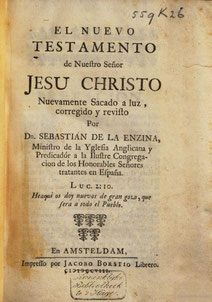
Sebastián de la Enzina was a Spanish preacher working in Amsterdam, of whom little information survives. He revised and improved the text of the Valera Bible into modern Spanish and had his Bible printed in Amsterdam. But beware, because sometimes the NT of Torres Amat also has the same title at the NT. The NT of Franzisco de Enzinas 1543 was clearly translated more accurately, in the NT of Sebastian de la Enzina compromises are made with his theological views.
Title 1708: „El Nuevo Testamento de Nuestro Señor Jesu Christo. Nuevamente Sacado á luz, corregido y revisto por Dn. Sebastian de la Enzina, Ministro de la Yglesis Anglicana y Predicador a la illustre Congregacion de los Honorables Señores tratantes en España. Luc. 2:10. Heaqui os doy nuevas de gran gozo, que sera a todo el Pueblo. En Amsterdam, Impresso por Jacobo Borstio Librero, 1708.“
Title 1817: „El Nuevo Testamento de Nuestro Señor y Redentor Jesu Cristo. Nueva Edicion, cuidadosamente corregida. Año de 1817.“
Facsimiles, online PDF download:
1708 Sebastian Enzina, Amsterdam: impresso por Jacobo Borstio librero (BDH, Signatura U/1114), Link2
1708 Sebastian Enzina, Amsterdam: Jacobo Borstio (Google Books)
1708 Sebastian Enzina, Amsterdam: Jacobo Borstio (Google Books)
1806 Sebastian Enzina: London: Samuel Rousseau (British Library, Digital Store 1408.g.9.), Link2, GB1, GB2
1807 Sebastian Enzina, Samuel Rousseau (Google Books)
1813 Sebastian Enzina, Bermondsey : Diego Powell (British Library, Digital Store 842.a.9.), Link2
1813 Sebastian Enzina, Bermondsey: Powell (Google Books), Link2
1817 Sebastian Enzina, (Archive)
1817 Sebastian Enzina, Londres: P. White (HathiTrust)
1817 Sebastian Enzina (Google Books), Google Books-2
1851 Sebastian Enzina, New York: Edicion Esteriotipica (Google Books)
Deutsch: Sebastián de la Enzina war ein in Amsterdam arbeitender spanischer Prediger, von dem nur wenige Informationen überliefert sind. Er revidierte und verbesserte den Text der Valera-Bibel in ein modernes Spanisch und ließ seine Bibel in Amsterdam drucken („El Nuevo Testamento de Nuestro Señor Jesu Christo“). Doch Vorsicht, denn manchmal trägt auch das NT von Torres Amat den gleichen Titel beim NT. Das NT von Franzisco de Enzinas 1543 wurde deutlich genauer übersetzt, im NT von Sebastian de la Enzina werden Kompromisse mit seinen theologischen Ansichten gemacht.
Spanish Gospel Manuscript from the 18th Century
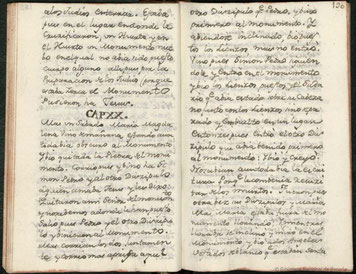
Until the end of the 18th century, the Catholic Church did not allow the Latin Bible (Vulgate) to be translated into Spanish. As a result, there were almost only Protestant Bibles in Spanish, which were mostly produced abroad and smuggled into the country. Official Catholic printing only began very late with Anselmo Petite in 1788, Scío de San Miguel in 1790 (NT; 1793 AT+NT) and Félix Torres Amat in 1823-25. An unknown Christian did not want to wait that long and dared to translate the Gospels himself. He did not copy the text from the Protestant Bibles, but spent countless hours editing the Gospels himself. He avoided ecclesiastical dogma and translated as it was originally meant. This very valuable and unique book (15 x 10 cm, 243 pages) shows how much effort some people have made to always have the Word of God with them. Today, many historical and new Bibles are even available for free, but how many people are really interested in them?
Facsimiles (Manuscrito evangélico español del siglo XVII):
17xx Gospel Manuscript (Biblioteca Digital Hispánica, Mss/5497), Link2
Tanakh Translation by Méndez de Castro 1762
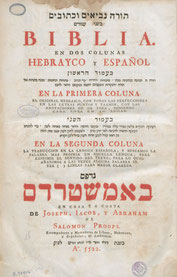
Abraham Méndez de Castro has translated the Tanakh (Old Testament) into Spanish. The the two-column work (Hebrew Spanish) work was printed in Amsterdam (en casa y a costa de Joseph, Iacob, y Abraham de Salomon Proops).
Title 1762 [5522]: „Torah Nevi’im u Khetuvim bi shne’amudim = Biblia en dos colunas hebrayco y español : en la primera coluna el original hebraico, con todas las perfecciones en las letras puntos y taamin, con las anotaciones de or tora poniendo cada coza en su lugar , en la segunda coluna, la traduccion en la lengua española, y buscamos la palabra mas propria en aquella lengua, para exprimir el sentido del texto; para lo qual añadimos a las vezes alguna palabra inter ( ) líneas para mayor clareza.– Amsterdam : en casa y a costa de Joseph, Iacob, y Abraham de Salomon Proops, estampadores y mercaderes de libros, hebraicos y españoles, Aº. 5522 [por Abraham Mendez de Castro].“
Facsimiles:
1762 Tanakh by Méndez de Castro, Amsterdam: Amsterdam: Joseph, Iacob, y Abraham de Salomon Proops (BDH), Link2
1762 Tanakh by Méndez de Castro, Amsterdam: Erven van Salomon ben Joseph Proops (Simurg), Link2, Link3
1762 Tanakh by Méndez de Castro, Amsterdam, Una Biblia sefardí (Universidad de La Laguna)
The Gospels by Anselmo Petite 1785
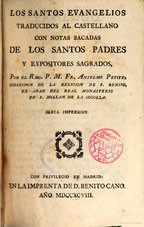
Fray Anselmo Petite (*1744; †1805; Wikipedia) was a Benedictine abbot of the monastery of San Millán de la Cogolla and one of the first translators of the Gospels into Castilian. When the Inquisition allowed the Bible to be translated into Spanish in 1782, recognized Catholics began to produce an official Bible. Until then, Catholic printings were mostly bilingual in order to compare the text with the Latin Vulgate. Anselmo Petite's NT is also bilingual. Gospels in Spanish and Latin, and the first complete translation of the Gospels authorized by the tribunal of the Holy Faith.
Title 1784 (Psalms): „Los Salmos Penitenciales en latín y castellano,con las letanías y Preces y una glosa de afectos morales sobre cada uno de sus versos... Los Salmos graduales en latín y castellano...“
Title 1787/88: „Los Santos Evangelios / traducidos al castellano con notas sacadas de los Santos Padres y Expositores Sagrados por el P.M. Fr. Anselmo Petite...“
Title 1854: „Los santos evangelios traducidos al castellano con notas sacadas de los santos padres y expositores sagrados por el Rmo. P. M. Anselmo Petite Nueva edición, con láminas“
Faksimiles:
1784 Petite Psalms, Vallaloid: en la Imprenta de la Viuda de D. Tomás de Santandér (GB), Link2, Link3
1786 Petite Psalms, Barcelona (GB)
1787 Petite Gospels, Vol.1 Mt+Mk, Madrid: En la Imprenta Real (Archive), Google Books
1788 Petite Gospels, Madrid: En la Imprenta Real (Archive)
1788 Petite Gospels, Madrid: en la Imprenta Real (BNE), Link2
1788 Petite Gospels, Madrid: Imprenta Real (liburutegibiltegi.bizkaia)
1788 Petite Gospels, Madrid: En la Imprenta Real (Archive), Link2
1789 Petite Gospels, Madrid: en la Imprenta Real, 4th edition (GB), Link2
1798 Petite Gospels, Madrid: Cano (GB)
1814 Petite Gospels, Barcelona: Sierra y Martí (Google Books)
1854 Petite Gospels, Paris: Rosa y Bouret (Archive), Link2, GoogleBooks, GB2
The Bible of Scío de San Miguel 1790 (NT) and 1793 (Bible)
Felipe Scio de San Miguel (*1738, †1796; Wikipedia) was appointed bishop by Pope Pius VI. The Spanish King Charles III (Carlos III; *1716, †1788; Wikipedia) commissioned him in 1780 to translate the Bible from the Vulgate into Spanish. The work was completed under King Charles IV (Carlos IV; *1748, †1819; Wikipedia). In 1790 the NT were printed in Valencia. Three years later (1793) the complete Bible was also finished. This Catholic Bible was the first printed Bible on Spanish soil in the national language. Until then, only the Latin Vulgate had been allowed, so no other complete Bible had been published in Spanish since the Biblia Alfonsina 1280. In contrast, there has been a flood of various printed German-language Bible translations in Germany since 1466 (Mentelin Bible). Other complete Spanish Bibles before the Scio Bible, such as the Biblia del Oso (1569) and the Biblia del Cántaro (1602), were produced abroad because they were not recognized by the Catholic Church. Since the Biblia de Scio was not forbidden, there was a great demand for it and many editions were printed both at home and abroad. Each biblical book was preceded by an introduction. The Scio version also contains a chronology, genealogies, and an index of names and places.
Title 1790 NT: „La Biblia. Vulgata Latina traducida en español, y anotada conforme al sentido de los Santos Padres y expositores cathólicos, Por el Padre Phelipe Scio de San Miguel, Ex-Provincial de las escuelas Plas, preceptor del Principe nuestro Señor y de los Señores infantes, y confesor de la Princesa del Brasil infanta de España. Dedicada al Rey nuestro Señor Don Carlos IV. Tomo I del Nuevo Testamento. Los quatro Evangelios. En Valencia en la oficina de Joseph y Thomas de Orga. Año de 1790 con Real permiso.“
Title 1794: „La Biblia. Vulgata Latina traducida en español, y anotada conforme al sentido de los Santos Padres y expositores catolicos, Por el P. Phelipe Scio de S. Miguel, de las escuelas Plas. Dedicada al principe de Asturias nuestro Señor. Segunda Edicion revista, corregida y aumentada por su mismo traductor... Madrid en la imprenta de Don Benito Cano. 1794 “
Facsimiles, online PDF download:
1790 NT Scio T. Evangelios (Biblioteca Valenciana Digital, bivaldi), Hechos de los Apóstoles y Apocalipsis
1794-97 Biblia Scio, Genesis, Madrid: D. Benito Cano (Biblioteca Digital Hispánica, U/6968 V.1), Link2
1794-97 Biblia Scio (Google Books): Vol.1, Vol.1, Vol.2, Vol.3, Vol.4, Vol.5, Vol.6, Vol.7, Vol.8, Vol.9, Vol.10, Vol.11,
Vol.12, Vol.13, Vol.14, Vol.15, Vol.16, Vol.17, Vol.18, Vol.19
1797 Biblia Scio, Londres: S. Bagster (Archive)
1807-08 Biblia Scio (Archive): Vol.1, Vol.1, Vol.2, Vol.3, Vol.4, Vol.5, Vol.5, Vol.6, Vol.7, Vol.8, Vol.9, Vol.10, Vol.11,
Vol.12, Vol.13, Vol.14, Vol.15, Vol.16, Vol.17, Vol.18, Vol.19, NT-2
1815-16 Biblia Scio (Archive): Vol.1, Vol.1, Vol.2, Vol.3, Vol.4, Vol.5, Vol.6, Vol.7, Vol.8, Vol.9, Vol.10, Vol.11,
1819 Biblia Scio, NT, New York: Edicion estereotipa por E. White (Archive)
1820 Biblia Scio, NT, Shacklewell: En la Imprenta de T. Rutt y Hijo (BDH, U/3400), Link2, Google Books
1820 Biblia Scio, Lucas en aymará y español (BDH, U/3540), Link2
1820 Biblia Scio, Bracelona: Impr. Dorca (Google Books)
1822 Biblia Scio, NT, Paris: J. Smith (Google Books), Link2
1823 Biblia Scio, NT, Nueva York : a costa de la Sociedad Americana de la Biblia (Archive), Link2
1823 Biblia Scio, NT, New York: Ed. estereotipa, por E. White (Google Books), Link2, Link3, Link4
1823 Biblia Scio, Impreso por Augusto Applégath (Google Books)
1825 Biblie Scio, London: S. Bagster (Google Books), Link2
1826 Biblia Scio, New York: Sociedad Americana de la Biblia (Google Books)
1827 Biblia Scio, Londres: Bagster y Thoms (Biblioteca Digital Hispánica, U/4093), Link2
1828 Biblia Scio, Londres: Clowes (Google Books), Link2
1829 Biblia Scio, New York: Edicion estereotipica por A. Chandler (Google Books)
1832 Biblia Scio, Nueva-York, Edición estereotípica por A. Chandler (archive)
1832 Biblia Scio, New York:Edicion estereotipica por A. Chandler (Google Books)
1835 Biblia Scio, NT, New York: Edicion estereotipa por E. White (Archive), Link2
1837 Biblia Scio, AT+NT, Barcelona: A. Bergnes (Biblioteca Digital Hispánica, 1/66240), Link2, Google Books
1837 Biblia Scio, NT, Madrid: Imp. a cargo de Joaquín de la Barrera (BDH, U/3316), Link2
1848 Biblia Scio, Tomo X, Threnos de Jeremías, Barúch, Ezechiel, Daniel (BDH, 3/48001), Link2
1848 Biblia Scio, Latein-Spanisch, Bd.11, 12-Propheten-Makk (Biblioteca Digital Hispánica, 3/53718), Link2
1848 Biblia Scio, Latein-Spanisch, NT, Bd.3 Epistel Pauli (Biblioteca Digital Hispánica, 3/107433), Link2
1852 Biblia Scio, Barcelona: Libreria religiosa (Archive)
1854 Biblia Scio, Madrid: Gaspar y Roig (Archive)
1855 Biblia Scio, London:A. y G.A. Spottiswoode (Google Books)
1857 Biblia Scio, NT, Londres (Archive)
1857 Biblia Scio, ondres (British Library, Digital Store 1609/3186.)
1869 Biblia Scio, Cambrigia, Impreso por C. J. Clay (Archive)
German: Felipe Scío de San Miguel (*1738, †1796; Wikipedia) wurde vom Papst Pius VI zum Bischof ernannt. Der spanische König Karl III (Carlos III; *1716, †1788; Wikipedia) beauftragte ihn 1780, die Bibel aus der Vulgata ins Spanische zu übersetzen. Unter König Karl IV (Carlos IV; *1748, †1819; Wikipedia) wurde das Werk fertig gestellt. Im Jahr 1790 wurde das NT in Valencia gedruckt. Drei Jahre später (1793) war auch die komplette Bibel fertig. Diese katholische Bibel war die erste gedruckte Bibel auf spanischem Boden in der Landessprache. Bis dahin war nur die lateinische Vulgata erlaubt, sodass seit der Biblia Alfonsina 1280 keine weitere vollständige Bibel in Spanisch veröffentlicht werden durfte. Im Kontrast dazu hat es in Deutschland seit 1466 (Mentelin Bibel) eine Flut an diversen gedruckten deutschsprachigen Bibelübersetzungen gegeben. Andere vollständige spanische Bibeln vor der Scio-Bibel, wie die Biblia del Oso (1569) und die Biblia del Cántaro (1602), wurden im Ausland hergestellt, da sie von der katholischen Kirche nicht anerkannt waren. Da die Biblia de Scio nicht verboten war, kam es zu einer großen Nachfrage und es wurden viele Auflagen im In- und Ausland gedruckt. Jedem biblischen Buch wurde eine Einleitung vorangestellt. Die Version von Scio enthält außerdem eine Chronologie, Genealogien und ein Namens- und Ortsregister.
The Bible of Félix Torres Amat 1823-25
The second Catholic Bible printed in Spain (Madrid) was translated from the Vulgate by Bishop Félix Torres Amat (*1772, †1847; Wikipedia). He was commissioned to do so in 1807 by the Spanish kings Carlos IV and Fernando VII. In addition to the Vulgate, however, the Biblia de Scío also served as the basis for the Torres Amat Bible.
Title 1823 Madrid: „La Sagrada Biblia. Nuevamente Traducida de la Vulgata Latina al Español, Aclarado el sentido de algunos lugares con la luz que dan los testos originals hehréo y griego, é illustrada con / varias notas sacradas de los Santos Padres y Espositores sagrados. Por Don Felix Torres Amat, Dignidad de Sacrista de la Santa Iglesia de Barcelona, electo Obispo de la misma: De orden del Rey N. S. Tomo I del Nuevo Testamento, que contiene los Santos Evangelios y los Hechos de los Apóstoles. Madrid: Imprenta de Dos Leon Amarita, Plazuela de Santiago, N. I. / 1823.“
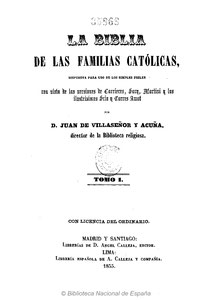
Title 1855: „La Biblia de las familias católicas, Dispuesta para uso de los simples fieles con vista de las versiones de Carrieres, Sacy, Martini y los ilustrisimos Scio y Torres Amat por Juan de Villaseñor y Acuña, director de la Biblioteca religiosa. Con Licencia del Ordinario. Madrid y Santiago: Librerías de Ángel Calleja, editor. Lima: Librería Española de Ángel Calleja y Compañia. 1855“
Title 1883 Barcelona: „La Sagrada Biblia. Traducida de la Vulgata Latina al Español, aclarado el sentido de algunos lugares con la luz que dan los textos originales hebreo y griego, é ilustrada con varias notas sacadas de los santos padres y expositores sagrados por Félix Torres Amat, Dignidad de Sacrista de la Santa Iglesia Catedral de Barcelona, individuo de la real Academia Española, de la de la Historia, etc. etc. etc. Nueva Edicion. ilustrada por Gustavo Doré con Licencia de autoridad Eclesiastica... Barcelona: Montaner y Simon, Editores, Calle de Aragon, Números 309 Y 311. 1823.“
Facsimiles, online PDF download:
1823 Biblia Torres Amat (Wikipedia)
1823 Torres Amat, Madrid: Imprenta de Dos Leon Amarita (todocoleccion)
1823-25 Torres Amat (Archive): Vol.1, Vol.2, Vol.3, Vol.4, Vol.5, Vol.6, Vol.7.Tomo1-NT, Vol.8, Vol.9, Vol.10, Vol.11,
Vol.12, Vol.13, Vol.14, Dictionario, Notas Generales
1823-25 Torres Amat (Google Books): Vol.1, Vol.2, Vol.3, Vol.4, Vol.5, Vol.6, Vol.7, Vol.7, Vol.8, Vol.9, Vol.10, Vol.11,
Vol.12, Vol.13, Vol.14,
1832-35 Torres Amat, Madrid: Miguel de Burgos, Vol.1-6 (Biblioteca Digital Hispánica, 1/50963), Link2
1832-35 Torres Amat (Google Books): Vol.1, Vol.1, Vol.2, Vol.3, Vol.4, Vol.5, Vol.5, Vol.5, Vol.6, Vol.7, Vol.8, Vol.9,
Vol.10, Vol.11, Vol.12, Vol.13, Vol.14, 1832 Vol.3 (Archieve)
1825 Biblia Torres Amat, Online Text, Bibliatodo.com, BibliaTotal, Online Text
1836 Torres Amat, Paris (Archive): Vol.1, Vol.2, Vol.3, Vol.4, Vol.5, Vol.6, Vol.7, Vol.8, Vol.9, Vol.10, Vol.11,
Vol.12, Vol.13, Vol.14, Vol.15, Vol.16
1837 Torres Amat, NT, Londres: Impr. por Ricardo Clay (Google Books)
1839 Torres Amat, Londres : Ricardo Clay (Google Books)
1852 Torres Amat, Londres : Ricardo Clay (British Library, Digital Store 3022.e.6.), Google Books
1855 Torres-Amat, Juan de Villaseñor y Acuña (Biblioteca Digital Hispánica, 1/58913, 1/58914), Link2
1855 Torres Amat, Edicion estereotypica, Nueva York, 1855 (British Library, Digital Store 3022.c.12.), GoogleB
1883-1884 Biblia Torres Amat, Barcelona: Montaner y Simón (Archive): Vol.1, Vol.2, Vol.3, Vol.4
German: Die zweite in Spanien (Madrid) gedruckte katholische Bibel wurde von dem Bischof Félix Torres Amat (*1772, †1847; Wikipedia) aus der Vulgata übersetzt. Den Auftrag dazu erhielt er 1807 von den spanischen Königen Carlos IV und Fernando VII. Neben der Vulgata diente aber auch die Biblia de Scío als Grundlage für die Torres-Amat-Bibel.
Biblia de Vence 1831
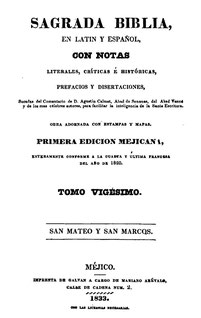
Until 1831, all Bibles came from Europe, whether Catholic or Protestant. Galván y Rivera's edition was the first to be printed in Latin America (Mexico). This Bible was published in 25 volumes and contained the Vulgate text on one column and the Spanish translation of the French Biblia de Port Royal 1767-73 (17 Volumes) with its marginal notes and commentaries on the other. The profuse notes, references, commentaries and reflections made by several French religious, among them Padre Henri-François de Vence (*1676; †1749) and the Benedictine abbot Augustine Calmet (*1672; †1757; Wikipedia), made the work known as the Bible of Vence. In the translation of this Bible, the 4th French edition of 1820 was used. The new edition appeared in 25 volumes between 1831 and 1836 and contained the text of the Vulgate as well as the Spanish text with all the notes and maps. This Bible was not widely used because the Torres Amat editions were preferred, as they were more practical and appeared in only one volume. Although this Bible was produced by Catholics, it is not categorized as Catholic due to the lack of additional Catholic texts and the mention of the Inquisition in some commentaries.
Title 1831: „Sagrada Biblia: en latin y español, con notas literales, críticas é históricas, prefacios y disertaciones, sacadas, Henri François de Vence.“
Facsimiles:
1831-1833 Biblia de Vence, Mexico (Archive), Vol.22
1831-1833 Biblia de Vence, Mexico (juanstraubinger)
1831-1883 Biblia de Vence, Vol.1 (GB), Vol.2, Vol.3, Vol.4, Vol.5, Vol.6, Vol.7, Vol.8, Vol.9, Vol.10, Vol.11, Vol.12,
Vol.13, Vol.14, Vol.15, Vol.16, Vol.17, Vol.18, Vol.19, Vol.20, Vol.21, Vol.22, Vol.23, Vol.24, Vol.25
French version:
1767 Saint Bible en latin et en français, Vol.1 (Archive), Vol.2, Vol.3, Vol.4, Vol.5, Vol.6, Vol.7, Vol.8, Vol.9,
Vol.10, Vol.11, Vol.12, Vol.13, Vol.14, Vol.15, Vol.16, Vol.17, Tablas
1838/39 Saint Bible en latin et en français, Vol.1 (GB), Vol1, Vol.2, Vol.3, Vol.4, Vol.5, Vol.6, Vol.7, Vol.8, Vol.9, Vol.10,
Vol.11, Vol.12, Vol.13, Vol.14, Vol.15, Vol.16, Vol.17
1889 Saint Bible en latin et en français, Vol.1 (Archive), Vol.2, Vol.3, Vol.4, Vol.5, Vol.6, Vol.7, Vol.8, Vol.9,
Vol.10, Vol.11, Vol.12, Vol.13, Vol.14, Vol.15, Vol.16, Vol.17
La Biblia Sagrada Version Cotejada 1850
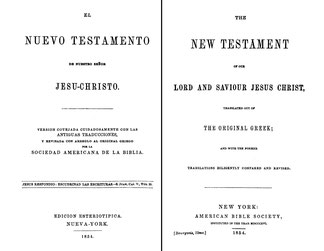
La Biblia Sagrada Version Cotejada 1850 is a Spanish-language translation of the Holy Scriptures that was published in New York by the American Bible Society (Sociedad Bíblica Americana) around the time of the Civil War (1861 to 1865). It contains a version of the text that is claimed to have been „diligently compared with ancient languages“ (version cotejada cuidadosamente con con las lenguas antiguas Specifically, this means that the content is reminiscent of the early revised version of Reina Valera 1831, which was edited again. The Cotejada version was revised in 1854. However, the two-column Spanish/English edition published in the same year, 1854, still had the original Spanish content. It was the first Spanish Bible to be printed on American soil. However, as it was a modification of the old Reina Valera versions, the 1928 Jünemann Bible (see below) was the first Bible printed in America to be translated only from the Greek NT and the Greek Septuagint (Old Testament).
Title 1850 Bible: „La Biblia Sagrada, Traducida en Español. Version Cotejada Cuidadosamente con las Lenguas Antiguas. Nueva-York: Edicion Esteriotipica [bound with:] El Nuevo Testamento de Nuestro Señor Jesucristo, Traducido en Español. Nueva York“
Title 1854 NT: „El Nuevo Testamento de Nuestro Señor Jesus-Christo. Version cotejada cuidadosamente con las antiguas traducciones, y revisada con arreglo al original griego por la Sociedad Americana de la Biblia. Edicion Esteriotipica. Nueva York…”
Facsimiles:
1850 Version cotejada Bible, 1st edition, Nueva-York (HathiTrust)
1850 Version cotejada Bible, 1st edition, Nueva-York (GB)
1851 Version cotejada Bible, Nueva-York (GB)
1851 Version cotejada NT, Nueva-York (GB)
1852 Version cotejada Bible, Nueva-York (HathiTrust)
1852 Version cotejada Bible, 3rd edition, Nueva-York (GB)
1854 Version cotejada NT, Spanish and English in parallel columns, Nueva-York (Archive)
1854 Version cotejada NT, Spanish and English in parallel columns, Nueva-York (HathiTrust)
1854 Version cotejada NT, Spanish and English in parallel columns, Nueva-York (GB)
Revised Version:
1854 Version cotejada Bible, Nueva-York (HathiTrust)
1855 Version cotejada NT, Nueva-York (GB)
1856 Version cotejada Bible, 6th edition, Nueva-York (Archive)
1856 Version cotejada Bible, 6th edition, Nueva-York (HathiTrust)
1856 Version cotejada Bible, 6th edition, Nueva-York (GB)
1861 Version cotejada NT, Nueva-York (GB)
1863 Version cotejada NT, Nueva-York HathiTrust)
1863 Version cotejada NT, Nueva-York (GB)
Versión Moderna 1893 and 1929
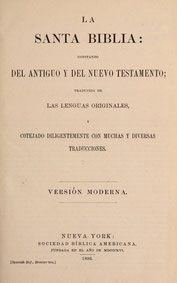
Enrique B. Pratt (*1832; †1912), a Presbyterian missionary in Colombia, translated the Bible into Spanish using a mixed translation of the original languages, the Septuagint, Vulgate, Reina Valera, Scío de San Miguel, Torres Amat and Petisco versions. It was published in 1893 by the American Bible Society (ABS). As it was difficult to read and riddled with Anglicisms, it was revised and published in a second edition in 1929. It did not catch on because the American Bible Society decided to publish the Reina Valera and no longer supported the printing of this version. Since this Bible did not always follow the original Greek text exactly and copied texts from other translators, it was not the first Spanish Bible produced on American soil that was translated from the Greek, but it was the Jünemann Septuagint Bible 1928 (NT).
Title 1893: „La Santa Biblia, constando del Antiguo y del Nuevo Testamento: traducida de las lenguas originales, y cotejado diligentemente con muchas y diversas traducciones: versión moderna“ - Translated: „The Holy Bible, consisting of the Old and New Testaments: translated from the original languages, and diligently compared with many and various translations: modern version.“
Facsimiles:
1893 Versión moderna, New York: Sociedad Bíblica Americana (Archive), Archive-2
1893 Versión moderna, New York: Sociedad Bíblica Americana (HathiTrust)
1893 Versión moderna, New York: Sociedad Bíblica Americana (commons.ptsem)
1929 Versión moderna revised 1929, Online Text, La Santa Biblia Moderna 1929 (biblicom)
2018 Versión moderna, Reprint (GB)
2020 Versión moderna revised 2020, La Santa Biblia Moderna 1929 actualizada 2020 (biblicom)
Jünemann Septuagint Bible 1928 (NT), 1992 (OT)
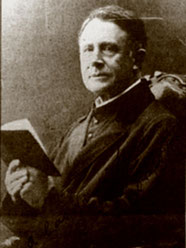
The first Spanish Bible printed in America. The Catholic priest Guillermo Junemann Beckschaefer (Wilhelm Jünemann Beckschäfer; *1856, †1938; Wikipedia), who emigrated to Chile from Germany, produced in 1928 the first Spanish translation of the Bible (Wikipedia) to be printed on American soil (Chile). He used the Septuagint (LXX, OT) and the Greek New Testament basic text as his source. Although the Bible was completed in 1928, only the NT could be printed in 1928; the complete Bible was not published until 1992. Jünemann has worked accurately, translated the passages in Jn 20:1; Acts 20:7 and 1Cor 16:2 excellently and speaks of the women coming to the tomb „on the one of the Sabbaths“, since there are three Sabbaths in the week of Passover (see Bible verses) and seven weekly Sabbaths between Passover (Nisan 15) and Pentecost (50th day), which must be counted every year according to God's biblical calendar. Jünemann also translated various other historical Greek books into Spanish.
There were other Spanish Bibles printed in America before that, but there is a big difference: It is the only direct Spanish translation, preferentially, though not exclusively, of the Greek texts of both Testaments, according to the usage of the primitive Church. And the most literal of all those that exist in the Spanish language.
Title 1912: „La Sagrada Biblia, Version de la LXX al Español“ - printed in Concepción, Chile
Title 1992: „La Sagrada Biblia“
Facsimiles, online PDF download:
1928 Biblia Jünemann, Online-Text (Bibliadoto.com)
1928 Biblia Jünemann, Online Text (bibliatotal), Link2
1928 Biblia Jünemann, Biblia Padre Guillermo Junemann, edited 1992 (Archive), PDF, ODT-file
1928 Biblia Jünemann, edited 1992 (allthyheart)
1928 Biblia Jünemann, edited 1992, Online Text (obohu)
1928 Biblia Jünemann, edited 1992, PDF Download, Conferencia Episcopal de Chile (Google Docs)
1928 Biblia Jünemann, Program with online text (juanstraubinger), ZIP-Download
1992 Biblia Jünemann, Video with explanations in Spanish (You Tube)
German: Die erste spanische Bibel, die in Amerika gedruckt wurde. Der aus Deutschland nach Chile ausgewanderte katholische Priester
Guillermo Junemann Beckschaefer (Wilhelm Jünemann Beckschäfer; *1856, †1938; Wikipedia) erstellte 1928 die erste spanische Bibelübersetzung (Wikipedia), die auf amerikanischem Boden (Chile) gedruckt wurde. Als Quelle dienten ihm die Septuaginta (LXX) und der
griechische Grundtext des NT. Obwohl die Bibel 1928 fertiggestellt wurde, konnte 1928 nur das NT gedruckt werden; die vollständige Bibel wurde erst 1992 veröffentlicht. Jünemann hat genau
gearbeitet, die Stellen in Joh 20,1; Apg 20,7 und 1Kor 16,2 hervorragend übersetzt und spricht davon, dass die Frauen „an einem der Sabbate“ zum Grab kamen, denn es gibt drei Sabbate in der
Passahwoche (siehe Bibelverse) und sieben Wochen-Sabbate zwischen Passah (Nisan 15) und Pfingsten (50. Tag), die jedes Jahr
nach Gottes biblischem Kalender gezählt werden
müssen. Es gab zwar schon andere spanische Bibeln, die in Amerika früher gedruckt wurden, aber es gibt einen großen Unterschied: Es ist die einzige direkte spanische Übersetzung,
vorzugsweise, wenn auch nicht ausschließlich, der griechischen Texte beider Testamente, gemäß dem Gebrauch der Urkirche. Und sie ist die wortgetreueste von allen, die es in spanischer Sprache
gibt.
Straubinger's Catholic Bible - Biblia Platense - Biblia Comentada 1948/51

The German Juan Straubinger (Johannes Straubinger; *1883; †1956; Wikipedia) was a translator who published his Bible with about 37,000 references and commentaries, which is why this Bible was also called the
Commentated Bible (Biblia Comentada; Wikipedia). This catholic
version 1951 is considered the first complete Catholic Bible in Spanish (based on the Hebrew and Greek texts) made in Latin America, with the exception of the
deuterocanonical books which are translated from the Latin Vulgate, since in Straubinger's opinion the Greek text of these is not always the best. Straubinger acknowledged in the preface to his
translation that the Jünemann Bible was an older biblical version than his own. However, the Old Testament of the Jünemann Bible had not yet been published by 1951. It was given the name
Biblia Platense because it was produced in the city of La Plata in Argentina. In 1941 (NT) and 1943 (Bible, La sagrada biblia: según la
Vulgata), the Catholic version of Félix Torres Amat was first revised according to the Vulgate text (Editorial
Guadalupe). Straubingers own Bible appeared shortly afterwards. The Gospels were finalized in 1944. the NT in 1948, the complete Bible was published in 1951 by Desclée de Brouwer. There were
several prints worldwide under different names: Los Santos Evangelios (La Plata, Argentina 1944), Hechos de los apóstoles (La Plata 1945), Cartas de San Pablo
(La Plata 1947), Nuevo Testamento (La Plata, Argentina
1948), Biblia comentada (La Plata, Argentina 1951),
Sagrada Biblia (USA 1958, 1963, 1969, 1972, 1974), Biblia comentada (Mexico 1969), La Santa Biblia (Argentina 1991), Sagrada Biblia (Spain 1995), La Santa
Biblia (Argentina 2007). The year of publication is usually not given in the PDFs offered on the Internet, but the 1951 text has been changed only slightly. However, the Jünemann Bible 1828
was more accurate in several verses, Straubinger was concerned with spreading Catholic views.
Title 1950 NT: „NUEVO TESTAMENTO / Traducción directa del original griego / por Monseñor Doctor Juan Straubinger / con todas sus notas completas según la fiel versión original“
Title 1951: „LA SAGRADA BIBLIA / Traducción directa de los Originales / por Monseñor Doctor Juan Straubinger / con todas sus notas completas según la fiel versión original“
Facsimiles and Online Text:
19xx Straubinger OT Vol.1 (Archive), Vol.2, Vol.3, Vol.4
19xx Straubinger OT (Archive), Archive2
19xx Straubinger NT (Archive), Archive2, Archive3, Archive4, Archive5
19xx Straubinger, correction 2 (Archive), Ver.2-Archive
19xx Straubinger, correction 4, 7 and 8 (Archive), correction-7- Archive, correction-8, correction-12-Archive
19xx Straubinger Bible, correction 9, PDF (Archive), Archive2, Correction 23 Archive, Archive4, Word-Doc-Archive
19xx Strauginger OT, PDF (gloria.tv), New Testament
Interlinear New Testament by Francisco Lacueva 1984
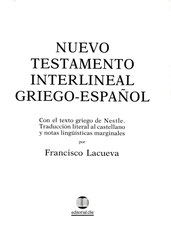
Interlinear New Testament (English-Greek) by Francisco Lacueva Lafarga (*1911; †2005; Wikipedia). It is not a concordant translation, but a free translation that makes compromises in order to be better understood in Spanish, which however sometimes changes the statements in the NT, as in the resurrection chapter of the NT, where no distinction is made between cardinal and ordinal numbers and where the Greek Sabbath in the singular and plural is equated with the week.
Title: „Nuevo Testamento Interlineal Griego Español. Con el texto griego de Nestle. Traducción literal al castellano y notas lingüísticas marginales por Francisco Lacueva.“
Facsimiles, online PDF download:
1984 Francisco Lacueva: NT by Joaquín Abreu (Archive), Link2, Link3
1984 Francisco Lacueva: Nuevo Testamento Interlineal Griego Español (escriturayverdad)
Reina Valera 2000 and Spanish Jubilee Bible 2000
see Sagradas Escrituras 1569 above
Las Escrituras de Restauracion Eidción del Nombre Verdadero 2004

Rabbi Moshe Yoseph Koniuchowskys is an evangelist who mainly addresses the Jewish population in New York and then in Florida. He is concerned with the quote "restoration of the true name of God" (Elohim, YHWH...) in the Bible (also NT), but he has changed the statements of the original Hebrew and Greek Bible, which is unacceptable. It is therefore an interpretative Bible, comparable to the work of Jehovah's Witnesses. Several editions followed, in which the text was changed again and again.
Title: 2014: „LAS ESCRITURAS DE RESTAURACIÓN / EDICIÓN DEL NOMBRE VERDADERO... / Las Escrituras Apartadas De La Nación De Yisrael En Restauración / Con Un Contenido Tanto Del Tanak Y Del Convenio Renovado / La Segunda Edición Completa En El Español / Traducida De La Cuarta Edición Actualizada En El Inglés / Supervisión Escritural y Administración Doctrinal / Por El Sholiach – Apóstol Mosheh Yoseph Koniuchowsky / YATI (Los Ministerios Internacionales De Sus Brazos A Yisrael) / El Condado De Baker, Florida – © 2014 / Revisado 01/01/5984 D.A. (Año Hebreo Aproximado Desde Ahdahm) – Abril 2014 (Año Romano).“
Online-Text:
2004-20xx RSTE, theWord/e-SWORD-Module, Link2
2005 RSTE, 2nd edition, PDF (Archive)
2006 RSTE, 3rd edition English (nonameszone)
2010 RSTNE, OT, PDF, Biblia Hebrea en Español Tanaj (academia), Link2, Link3
20xx RSTNE Comentario Biblico de Escrituras NV (bibliatodo)
20xx RSTNE, 8th edition, Webseite RSTNE Scriptures
Interlinear NT by César Vidal 2011
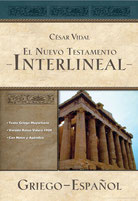
César Vidal: „El Nuevo Testamento interlineal griego-español.“ The Greek text of this New Testament is based on the Textus Receptus, which served as the
basis for the great Bible translations into other languages, e.g. the Reina Valera translation, the King James translation (English) or Luther's translation (German). It is not a concordant
translation, but a free translation that makes compromises in order to be better understood in Spanish, which however sometimes changes the statements in the NT. Interlinear but not always
accurate
Facsimiles, online PDF download:
2011 César Vidal: Nuevo Testamento interlineal griego-español (academia)
2011 César Vidal: Nuevo Testamento interlineal
griego-español (Google Books)
2011 César Vidal: Interlineal del NT Griego-Español, J. Abreu (Archive)
Interlinear NT by MAB - Ministerio Apoyo Bíblico 2011, 2013
Interlinear Translation from Ministerio Apoyo Bíblico, MAB, an Independent Bible Church (Iglesia Bíblica Independiente; IBI) from Argentina. The NT contains the literally translated Greek basic text and in two columns next to it the revised Reina-Valera Bibles 1909 and 1960.
Title 2011: „Nuevo Testamento. Interlineal Griego - Español de los manuscritos Bizantinos [Texto Mayoritario] con las variantes más significativas del Textus Receptus. En paralelo con las Versiones. Versión Reina Valera 1909, Versión Reina Valera 1960. Armonizado lingüísticamente. 1ª Edicion. © Realizado por la Iglesia en Salta - Argentina. Ministerio Apoyo Bíblico.“
Title 2013: „Nuevo Testamento Interlineal Codificado Griego - Español Traducción de los manuscritos Bizantinos [Texto Mayoritario]. Texto Bizantino. Dicctionario Griego Español Codificado. Concordancia Griego Español Codificada. Dicctionario Morfologico Codificado.“
Facsimiles, online PDF download:
2011 MAB, Ministerio APOYO BÍBLICO - Website
2011 MAB, Ministerio Apoyo Bíblico, Interlineal Griego - Español (eventosbiblicos), Academia
2011 MAB, Ministerio Apoyo Bíblico, Interlineal Griego - Español (escriturayverdad), PDF
2012 MAB, Muestra Concordancia Diccionario MAB Griego Español Del NT (Archive)
2012 MAB, Historia de Las Escrituras (Archive)
2012 MAB, Profecías Del Libro De Daniel (Archive)
2013 MAB, Ministerio Apoyo Bíblico, Interlineal Griego - Español, Epístola a los Gálatas (Archive), PDF
2013 MAB, Interlineal Griego - Español, Libro de Gálatas (Archive)
2016 MAB, Septuaginta Genesis Interlineal Griego Español (Archive), PDF
2016 MAB, Cartilla El Evangelio Biblico (Archive)
2018 MAB, Genesis TANAJ Interlineal Hebreo Español Con RVIC (Archive)
2018 MAB, Daniel TANAJ Interlinear Hebreo Español Con RVIC (Archive)
2022 MAB, El Nou Testament Interlineal codificat Grec-Català (Archive)
Reina Valera Indepediente 2012

Interlinear Bible by MAB - Ministerio Apoyo Bíblico - from Argentina. This two-column Bible shows the Revised Reina Valera 1909 and next to it the new RVI (MAB). The differences between the two versions are very small.
Title Bible: „Biblia Reina Valera Indepediente. TEXTO ESPAÑOL LATINO Basado en Reina 1569 - Valera 1602 - Revisión 1909 NT ajustado al Texto Mayoritario, con las variantes más significativas del Textus Receptus 1551“
Title NT: „Nuevo Testamento Reina Valera Indepediente. En Paralelo RV1909. Texto basado en Reina 1569, Valera 1602, Revision 1909 Ajustado a los manuscritos Bizantinos [Texto Mayoritario] Con las variantes mas significativas del Textus Receptus 1551“
Facsimiles and PDF:
2012 RVI, MAB Ministerio Apoyo Bíblico (Website), Link2
2012 RVI, Biblia Reina Valera Independiente, MAB Ministerio Apoyo Bíblico (Archive), PDF
2012 RVI, NT, Parallel Bible: RVI and RV1909 New Testament Diglot (Archive), Link2
LogosKLogos, Biblia Interlineal de Nuevo Testamento Tischendorf 2016-2024
This is an excellent example of how the best texts are often available for free, but many Christians do not know this and instead buy expensive interlinear Bibles that are not as accurate. An easy and simple tool to read, compare and analyze the bible in depth in its original language with online Interlinear Bible, Strong's Greek Dictionary and Strong's Hebrew Dictionary. This very accurate and free service is based on the Bibles: Reina Valera 1960 (Spanish), Tischendorf's 8th edition Greek New Testament con morphological tags Versión 2.7, G. Clint Yale's Tischendorf text, Dr. Maurice A. Robinson's Public Domain Westcott-Hort text and Biblia Hebraica Stuttgartensia (Hebrew OT). © Copyright LogosKLogos.
Title: „Biblia Interlineal de Nuevo Testamento Tischendorf.“
Online Text:
2016 Logosklogos: Biblia Interlineal de Nuevo Testamento Tischendorf, Online Text (logosklogos)
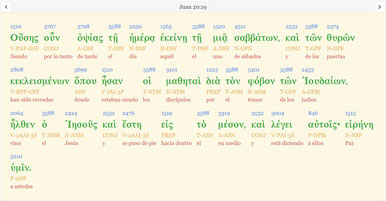
The LogosKLogos website is amazingly accurate and shows the resurrection of Jesus on a Sabbath morning (see proofs), more precisely on the „first Sabbath“ (Mk 16:9). This always means the first Sabbath of a series of altogether 7 Sabbaths, which according to the biblical calendar of God have to be counted every year between Passover (15th Nisan) and Pentecost and can be found in every Jewish calendar. The basic Greek text speaks neither of the „first day of the week“ nor of „a Sunday“, but calls the Sabbath by name seven times in the resurrection chapter of the NT (read more).
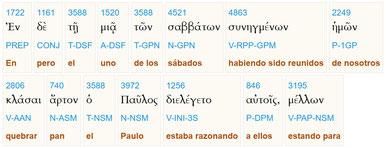
German: Dies ist ein hervorragendes Beispiel dafür, dass die besten Texte oft kostenlos verfügbar sind, aber viele Christen wissen das nicht und kaufen stattdessen teure Interlinear-Bibeln, die nicht so genau sind. Es ist ein leichtes und einfaches Werkzeug, um die Bibel in ihrer Originalsprache zu lesen, zu vergleichen und zu analysieren, mit der Online-Interlinear-Bibel, dem Strong's Greek Dictionary und dem Strong's Hebrew Dictionary.
Dieser sehr genaue und kostenlose Service basiert auf den Bibeln: Reina Valera 1960 (Spanisch), Tischendorfs 8. Ausgabe des Griechischen Neuen Testaments mit morphologischen Tags Version 2.7, G. Clint Yale's Tischendorf Text, Dr. Maurice A. Robinson's Public Domain Westcott-Hort Text und Biblia Hebraica Stuttgartensia (hebräisches AT).
Die LogosKLogos-Website ist erstaunlich genau und zeigt die Auferstehung Jesu an einem Sabbat-Morgen (Beweise), genauer gesagt an dem "ersten Sabbat" (Mk 16,9). Damit ist immer der
erste Sabbat einer Serie von insgesamt 7 Sabbaten gemeint, die gemäß dem biblischen Kalender Gottes jedes Jahr zwischen Passah (15. Nisan) und Pfingsten gezählt werden müssen und in jedem jüdischen Kalender zu finden
sind. Der griechische Grundtext spricht weder vom „ersten Tag der Woche“ noch von „einem Sonntag“, sondern nennt im Auferstehungskapitel des NT den Sabbat sieben Mal beim Namen (mehr dazu).
Spanish Interlinear Edition by Sociedad Bíblica de Canadá 2018
Title 2018: "La Biblia Interlinear Español / Griego: Con definiciones de diccionario para cada palabra griega." Spanish edition by Sociedad Bíblica de Canadá. This is the Spanish - Hebrew / Greek interlinear Bible. Each Greek or Hebrew word is translated into Spanish. In addition, each word is linked to a dictionary definition. The result is an excellent resource for those seeking to become familiar with the original languages of the Bible.
List of historical and modern Spanish Bibles
The following list also corresponds to the information in Wikipedia and Versiones en español de la Biblia católica. Most of the Bibles most important to us are listed above in the text with the respective links to the fascimiles and online texts. This list contains the Spanish Bible of all denominations. Below this table is the list of only Catholic Bibles:
- 1220-1235 Travel report with translated excerpts from the OT and NT, see above
- 1260 Biblia Alfonsina, catholic Bible (Toledo; Reino de Castilla), see above.
- 1416-1458 Biblia de Alfonso V de Aragón. Translation of the OT in Spanish from Hebrew and Latin, sponsored by Alfonso V el Magnánimo (Alfonso V the Magnanimous) (Zaragoza, Reino de Aragón), see above.
- 1420 Antiguo Testamento del rabino Salomón. Old Testament of Rabbi Solomon.
- 1420 Antiguo Testamento de traductor anónimo. Old Testament by anonymous translator.
- 1422-1433 Biblia de Alba (Biblia de Arragel), catholic Bible (Madrid, Reino de Castilla), see above.
- 1450 Espistolas y Evangelios by Martín de Lucena, part of the Biblia Romanceada del Marqués de Santillana. Excerpts from the Bible with Catholic interpretations for the church year, see above.
- 1450 Evangelios y Epístolas Paulinas (Gospels and Epistles) by Martín González de Lucena, part of the Biblia Romanceada del Marqués de Santillana, see above.
-
1484 Espistolas y Evangelios, Gonzalo García de Santa María. The first printed
edition of any part of the Bible in Castilian (Zaragoza, Kingdom of Aragon). Excerpts from the Bible with Catholic interpretations for the church year, see above.
- 1512 Espístolas y Evangelios del año by Fray Ambrosio de Montesino. Translation of the readings of the Roman Missal based on the version of Gonzalo Garcia de Santa Maria at the request of the Catholic kings. It was later revised by Román de Vallzillo in 1586. (Antwerp, Habsburg Netherlands and Barcelona, Spain).
- 1529 First Protestant translation of the Bible (Gospel of Matthew) into Spanish by Juan de Valdés. Part of the Diálogo de Doctrina Cristiana (Alcalá de Henares, Spain).
-
1543 El Nuevo Testamento de Nuestro Redemptor y Salvador Iesu Christo... by
Francisco de Enzinas Antwerp (Ambres, Flanders), see above.
1553 Ferrera Bible, Biblia de Ferrara, Biblia Ladino, see above. - 1556 Nuevo Testamento de Juan Pérez de Pineda, (Basilea, Suiza), see above.
- 1567 (NT), 1569 (OT+NT) Bear Bible (Biblia del Oso), Biblia de Casiodoro de Reina, see above.
- 1569 Sagradas Escrituras by Russell Martin Stendal published in 1996.
- 1572 Partial, unpublished, unprinted translations, for private use by Fray Luis de León; of the Song of Songs and the Book of Job. Direct from the Hebrew. They caused him to be denounced before the Inquisition, and to be imprisoned (Salamanca, España).
- 1602 Reina Valera (RV), Biblia del Cántaro, see above.
- 1611 Biblia Ladino, see above.
- 1708 Biblia de Sebastián de la Enzina, see above.
- 1784, 1788 Petite Psalms and Gospels, see above.
- 1785 Los Santos Evangelios by Anselmo Petite (Madrid, Spain), see above.
- 1789 Acts by D. Francisco Ximénez, presbyter: BdH1, BdH2
- 1789 Apocalypsis by Josef de Palacio y Viana (Madrid, Spain).
- 1790 (NT), 1793 (OT+NT) Biblia de Scío, catholic Bible, see above.
- 1823-25 Biblia de Félix Torres Amat, catholic Bible, Astorga (Spain), see above.
- 1831 Biblia de Vence or La Biblia de Port Royal (Mexico), see above.
- 1850 La Biblia Sagrada, Version Cotejada Cuidadosamente con las Lenguas Antiguas, see above.
- 1855 La Biblia de las familias católicas (Juan de Villaseñor y Acuña): BdH
- 1856 Matthew-Gospel by Antonio María Claret (1807-1870): BdH1, BdH2
- 1858 Las Escrituras del nuevo Pacto, Guillermo Norton.
- 1865 Valera1865, Valera 1602 reprinted by the America Bible Society, revised by Dr. Ángel de Mora.
- 1893 La Santa Biblia constando del Antiguo y el Nuevo Testamento, Versión Moderna by Enrique B. Pratt; New York : Sociedad Bíblica America (Colombia), see above.
-
1903 Nuevo Testamento de Juan José de la Torre. Catholic Bible. Translation
from the Greek edited by Herder, the translator was an Argentine Jesuit. The bilingual two-column Greek-Spanish study edition was the first critical Spanish edition. Printed in Spain:
Archive, Archive-2,
Theological Commons, JuanStraubinger
- 1916 BHTI, El Nuevo Testamento de nuestro Señor Jesucristo: versión hispano-americana. Madrid: Archive, Bibliatodo
- 1920 El Nuevo Testamento de Nuestro Señor Jesucristo by Carmelo Ballester Nieto. It is based on the Torres Amat Bible, adding notes, commentaries and illustrations.
- 1925 Sagrada Biblia, La Biblia Cristera. Catholic Bible. Author: Editorial La Revista Católica and Ignatian Society of Texas. Uses the Torres Amat as a basis for an exhaustive revision. With notes and exegetical division of the text. El Paso, Texas.
- 1928 (NT), 1992 (OT) Biblia Jünemann, catholic Bible, Concepción (Chile), see above.
-
1938-1944 Sagrada Biblia Nácar-Colunga by Eloíno Nácar Fúster y Alberto Colunga
Cueto. First Spanish Catholic translation, direct and literal, from Hebrew,
Aramaic and Greek. It is published by the Biblioteca de Autores Cristianos (BAC). España: 1938-Archive, 1944-Archive, 1951-Archive.
- 1947 Biblia Bóver-Cantera, Sagrada Biblia Bover-Cantera. José María Bover y Francisco Cantera Burgos. A direct and literal Spanish translation of numerous primitive biblical sources. Considered one of the first Catholic critical Bibles, published by the Biblioteca de Autores Cristianos (BAC). Spain. 1646-Matthew, 1947-Vol.1, 1947-Vol.2, 1950-Epistles, 1952-Archive.
- 1948 (NT), 1951 (Bible), Straubinger's Catholic Bible, Biblia Platenese (Argentina), Biblia Comentada: Nuevo Testamento de monseñor Straubinger, see above.
- 1954 Nuevo Testamento. Asociación para el fomento de estudios bíblicos en España (AFABE). astoral translation based on the Greek texts. Catholic Bible. Spain
- 1958, 1963, 1969, 1972, 1974 Revision of Straubinger 1951: Sagrada Biblia (Chicago, USA).
- 1960 Biblia Reina-Valera 1960. Revised in 1602 by Casiodoro de Reina and Cipriano de Valera (see Reina-Valera), published by the United Bible Societies.
- 1961 Nuevo Testamento. Centro de Estudios Bíblicos Hispanoamericano (CEBIHA). Translation from the Greek. Catholic Bible. Spain-Mexico.
- 1961 Sagrada Escritura. Texto y comentario por los Profesores de la Compañía de Jesús. Archive: Vol.1, Vol.1, Vol.2, Vol.3, Vol.4, Vol.5, Vol.6, Vol.7-Evangelios, Evangelios-2, Vol.8-Acts, Acts-2, Vol.9, Epistles
- 1962 Sagrada Biblia.Francisco Cantera Burgos y José Manuel Pabón. Translation from the original Hebrew and Greek texts with notes by the monks of the Abbey Abadía del Valle de los Caídos. Catholic Bible. Spain.
- 1963 Traducción del Nuevo Mundo de las Escrituras Griegas Cristianas. Based on English/Original Text. Published by Watch Tower Bible and Tract Society of Pennsylvania, Jehovah's Witnesses.
- 1964 La Santa Biblia. Equipo dirigido por Evaristo Martín Nieto. Direct and literal Spanish translation from Hebrew, Aramaic and Greek. First Catholic Bible made as a team. There are three revisions (1988, 1992 and 2012). It is published by Editorial San Pablo. Spain: Bibliatodo
- 1965 Sagrada Biblia by Pedro Franquesa y José Solé, Title: Sagrada Biblia; versión sobre los textos originales, introducción y notas bajo la dirección de los padres Pedro Franquesa y José Mª Solé; Misioneros claretianos; Spain
- 1966 Biblia de Jerusalén. Translation from French. Translation of numerous early biblical sources, with exegetical notes, according to the parameters of its French sister, La Bible de Jérusalem (1966), both produced by the Ecole Biblique de Jérusalem. It has been revised in 1975, 1998, 2009 and 2018.3637 It is usually published by Desclée De Brouwer.
- 1966 Nuevo Testamento by José María Valverde. Translated from the Greek and revised by Luis Alonso Schökel. Spain
- 1967-2009 Biblia de Jerusalén. Team directed by Victor Morla. Catholic Bible. Paris-Bilbao-Madrid
- 1967 Biblia traducción del Nuevo Mundo. Translation from English. 1967-Archive, 1987-Archive
- 1967 El evangelio según San Mateo by Josef Schmid, Herder: Archive-1973, PDF
- 1968 Biblia de Editorial Labor.
- 1968 Biblia Pontificia, Hebrew-Greek translation based on the Italian edition. It was published by Editorial Labor. Supported by the Pontifical Biblical Institute of Rome. Spain
- 1969 Revision of Straubinger 1951: Biblia comentada, Tlalnepantla, México; see above Straubinger 1948/1951
- 1972 Biblia Latinoamericana. Team directed by Monsignor Ramón Ricciardi and Bernardo Hurault. Elsewhere called "Biblia edición pastoral para Latinoamérica". Catholic Bible. Chile.
- 1975 La Biblia de editorial Herder.
- 1975 Sagrada Biblia. Cantera-Iglesias, Francisco Cantera Burgos and Manuel Iglesias. Catholic Bible. Madrid (Spain).
- 1975 La Biblia. Team directed by Serafín de Ausejo. Catholic Bible. Barcelona (Spain).
- 1975 Nueva Biblia Española. Team under the direction of Luis Alonso Schökel and Juan Mateos. Catholic Bible. Madrid (Spain)
- 1976 Biblia de Jerusalén: Bibliatodo
- 1976 Nueva Biblia Española (de Juan Mateos, Luis Alonso Schökel). Google Books-1987, Wkipedia
- 1978 Sagrada Biblia de Magaña. Agustín Magaña Méndez. Catholic Bible. Mexico.
- 1978 Biblia Interconfesional.
- 1979 Dios Habla Hoy o Versión Popular (DHH). Spanish translation from Hebrew, Aramaic and Greek. Launched and promoted by the United Bible Societies, with the collaboration of Evangelical and Catholic scholars, with the approval of the Latin American Episcopal Conference.
- 1979 La Biblia al Día. Spanish paraphrase published by the International Bible Society. A revision was published in 2008 under the name of La Nueva Biblia al Día (NBD).
- 1980 Biblia el libro del pueblo de Dios: Vatican, Bibliatodo, SanPablo
- 1981 El Libro del Pueblo de Dios. Armando Levoratti y Alfredo Trusso. Catholic Bible. Buenos Aires (Argentina).
- 1983-2004 Nuevo Testamento de la Universidad de Navarra. Catholic Bible.
- 1986, 1995, 1997 La Biblia de las Américas (LBLA), published by the Lockman Foundation. Bibliatodo
- 1987 Traducción del Nuevo Mundo de las Santas Escrituras. Based on English/Original Text. Published by Watch Tower Bible and Tract Society of Pennsylvania. Jehovah's Witnesses.
- 1989 Biblia, versión revisada por un equipo de traductores dirigido por Evaristo Martín Nieto.
- 1989 Reina-Valera Actualizada (RVA), published by the Editorial Mundo Hispano.
- 1991 Revision of Straubinger 1951: La Santa Biblia, versión de Mons. Juan Straubinger. Buenos Aires, Argentina
- 1992 Biblia Casa de la Biblia.
- 1992 La Biblia. Team directed by Santiago Guijarro and Miguel Salvador. Catholic Bible. Madrid (Spain).
- 1993 Biblia del Peregrino. Team directed by Luis Alonso Schökel and Juan Mateos. Catholic Bible.
- La Biblia de Nuestro Pueblo (traducido por Luis Alonso Schökel). Wikipedia, Bibliatodo
- 1994 Nuevo Testamento versión Recobro.
- 1994 Biblia Americana San Jerónimo. Jesús María Lecea. Catholic Bible. Valencia (España).
- 1994 The Edicep publishing house of Valencia published "la Biblia americana de San Jerónimo", a revision of the Scio Bible 1793.
- 1995 Revision of Straubinger 1951: Sagrada Biblia, Madrid, España, see above Straubinger 1948/1951.
-
1996 Biblia del Peregrino by Luis Alonso Schökel: Archive
- 1998 Nueva Biblia de Jerusalén.
- 1999 Nueva Versión Internacional (NVI): Bibliatodo-1999, Bibliatodo-1984, Biblegateway, Bible.com, BibleServer
- Nueva Versión Internacional (Castilian) (CST), BibleServer, Link2
- 1999, 2010 Biblia Textual (BTX), Sociedad Bíblica Iberoamericana, BibleServer, Link2
- 2000 Nuevo Testamento by Pedro Ortiz. Catholic Bible. Bogotá (Colombia).
- 2000 Nuevo Testamento la Palabra de Dios para Todos (PDT); full Bible 2005, Biblegateway, Bibliatodo.
- 2000 Reina Valera (RV) 2000. Bibliatodo
- 2000 VALERA1865, revised by Dr. Ángel de Mora, 1865, reprinted by the Valera Bible Society 2000.
- 2001 Biblia de América. Team directed by Santiago García. Catholic Bible.
- 2003 Traducción en lenguaje actual (TLA): Bibliatodo, Biblegateway, Bible.com
- 2004 Reina Valera Gómez, Publicada por Iglesia Bautista Libertad.
- 2004 Las Escrituras de restauracion Eidción del Nombre Verdadero. see above
- 2004 Biblia de Navarra. Team directed by José María Casciaro. Catholic Bible. Pamplona (Spain).
- 2005 Biblia la Palabra de Dios para Todos (PDT), 2000: NT, see above, Biblegateway, Bibliatodo.
- 2005 Biblia Católica para Jóvenes [=Catholic Bible for Young People]. The biblical text corresponds to the edition of the Bible of America. Catholic Bible. USA.
- 2005 Nueva Biblia de las Américas (NBLA), published by the Lockman Foundation. Formerly known as Nueva Biblia Latinoamericana de Hoy (NBLH), Nueva Biblia de los Hispanos (NBH), y Nueva Biblia Latinoamericana (NBL)
- 2006 La Biblia Peshitta en Español, Instituto Cultural Álef y Tau, A. C. Holman Bible Publishers Nashville
- 2007 La “RV-1602” Purificada 2007
- 2007 Revision of Straubinger 1951: La Santa Biblia. La Plata, Argentina; see above Straubinger 1948/1951
- 2008 Nueva Biblia al día (NBD), Published by Thomas Nelson.
- 2008 Nuevo Testamento de Arcas-Fernández y Alfonso Fernández.
- 2009 La Biblia del Siglo de Oro.
- 2009 Biblia de Jerusalén de 2009, Ed. Desclée de Brower: Instituto de Pastoral
- 2009 Reina-Valera 2009, Published by The Church of Jesus Christ of Latter-day Saints.
- 2009 Nueva Reina-Valera Versión Siglo XXI, Published by Sociedad Bíblica Emanuel.
- 2010 Nueva Traducción Viviente (NTV), Published by Tyndale Español.
- 2010 Sagrada Biblia. Versión oficial de la Conferencia Episcopal Española. Official version of the Spanish Episcopal Conference. It is the translation of the Bible to be used in the liturgy, catechisms and manuals for the teaching of religion in schools. Catholic Bible. Madrid (Spain): PDF
- 2011 Reina Valera Contemporánea, Published by Sociedades Biblicas Unidas (United Bible Societies).
- 2011 Nuevo Testamento Judío by Dr. David H. Stern published by Messianic Jewish Resources International.
- 2011 César Vidal: El Nuevo Testamento interlineal griego-espanol. Grupo Nelson, USA.
- 2011 MAB, Ministerio Apoyo Bíblico. Nuevo Testamento. Interlineal Griego - Español de los manuscritos Bizantinos [Texto Mayoritario] con las variantes más significativas del Textus Receptus. En paralelo con las Versiones. Versión Reina Valera 1909, Versión Reina Valera 1960. Armonizado lingüísticamente. 1ª Edicion. © Realizado por la Iglesia en Salta - Argentina. Ministerio Apoyo Bíblico. See above
- 2012 Reina Valera Independiente, MAB, Ministerio Apoyo Bíblico, see above Reina Valera 1602.
- 2012 Las Sagradas Escrituras, Versión Israelita Nazarena, Published by El Candelero de Luz, Inc. in Puerto Rico.
- 2013 Nuevo Testamento Vivir en Cristo. Text based on the Latin Vulgate and modern versions in Spanish by José A. Ramos with cathectical, doctrinal and apologetic notes. Catholic Bible. Mexico.
- 2013 Biblia Católica de la Familia [Catholic Family Bible]. Edited by the Center for Ministry Development y Editorial Verbo Divino. Text based on P. Levoratti's version. Catholic Bible. USA.
- 2014 La Sagrada Biblia de Mons. Straubinger Revisada. Team led by Alfonso Ramos. Revision of the translation of Bishop Juan Straubinger digitized from the new dispositions of Spanish and modern translations of the Bible. It began in 2011 in Chihuahua, Mexico with the collaboration of people from Colombia, Argentina, Nicaragua, Costa Rica, Spain, United States and Mexico. Catholic Bible. Chihuahua (México). see above Straubinger 1948.
- 2015 Biblia de la Iglesia en América (BIA). Conferencia del Episcopado Latinoamericano CELAM; Santiago Silva Retamales, Carlos Junco Garza, Adolfo Miguel Castaño Fonseca, Ramón Alfredo Dus. A translation made from the Hebrew, Aramaic and Greek texts in order to provide the Spanish-speaking Catholic Church in America with an official version that unifies with official recognition of a version for Catholics from the United States to Tierra del Fuego. The New Testament was presented to Pope Francis in May 2015. Catholic Bible. Chile.
- 2016 Logos K Logos: Biblia Interlineal de Nuevo Testamento Tischendorf. An very accurate interlinear Bible, see above.
- 2016 Testamento Reina Valera - SBT (RV-SBT) by Sociedad Bíblica Trinitaria. This work, begun in 2008, is a new revision of the New Testament Reina Valera 1909 but collated with different versions of the Textus Receptus from the time of Cassiodorus de Reina and Cyprian of Valera under a traditional Protestant theology. Spain.
- 2017 La Santa Biblia Rey Jacobo.
- 2019 La Biblia. Traducción del Nuevo Mundo. Based on English/Original Text. Published by Watch Tower Bible and Tract Society of Pennsylvania.
- 2020 La Biblia: Texto en lenguaje actual, La Biblia Platense with text in current language, a work carried out by the team of Editorial Santa María. It replaces "Yahweh" with "Lord", eliminates the "vosotros" and the corresponding verb forms, and corrects the translation in some points. It maintains, however, all the notes of the Platense Bible. Argentina
- 2023 Reina Valera - SBT (RV-SBT) by Sociedad Bíblica Trinitaria. A team of revisers from the Trinitarian Bible Society from different countries carried out a textual restoration and grammatical revision work, seeking accuracy with the original Greek text and at the same time an adaptation to the language according to the current norms of the Spanish language, Spain.
List of Spanish Catholic Bibles
Summary from the Wikipedia website, Wiki2, and own information (most of the Bibles most important to us are listed above in the text with the respective links to the fascimiles and online texts):
- 1260-1280 Biblia alfonsina (Spain).
- 1416-1458 Biblia de Alfonso V de Aragón (Spain).
- 1422-1433 Biblia de Alba (Moisés Arragel) (Spain).
- 1793 Scío de San Miguel (Spain).
- 1825 Félix Torres Amat (Spain).
- 1903 NT, Juan José de la Torre (Spain).
- 1925 Sagrada Biblia, La Biblia Cristera. Editorial La Revista Católica y Ignatian Society of Texas (El Paso, Texas).
- 1928 Guillermo Jünemann (Concepción in Chile).
- 1944 Sagrada Biblia Nácar-Colunga by Eloíno Nácar Fúster y Alberto Colunga Cueto (Spain).
- 1947 Sagrada Biblia Bover-Cantera, José María Bover y Francisco Cantera Burgos (Spain).
- 1948-1951 Biblia Platense, Juan Straubinger (La Plata in Argentina).
- 1954 NT, Asociación para el fomento de estudios bíblicos en España (AFABE).
- 1961 NT, Centro de Estudios Bíblicos Hispanoamericano (CEBIHA) (Spain and Mexico).
- 1962 Francisco Cantera Burgos y José Manuel Pabón (Spain).
- 1964 Equipo dirigido por Evaristo Martín Nieto (Spain).
- 1967-2009 Biblia de Jerusalén, Equipo dirigido por Víctor Morla (París-Bilbao-Madrid).
- 1972 Biblia Latinoamericana, Equipo dirigido por monseñor Ramón Ricciardi y Bernardo Hurault (Chile).
- 1975 Sagrada Biblia Cantera-Iglesias, Francisco Cantera Burgos y Manuel Iglesias (Madrid, Spain).
- 1975 Equipo dirigido por Serafín de Ausejo (Barcelona, Spain).
- 1975 Nueva Biblia Española, Equipo bajo la dirección de Luis Alonso Schökel y Juan Mateos (Madrid, Spain).
- 1978 Sagrada Biblia de Magaña, Agustín Magaña Méndez (México).
- 1981 El Libro del Pueblo de Dios, Armando Levoratti y Alfredo Trusso (Buenos Aires, Argentina).
- 1983 Nuevo Testamento de la Universidad de Navarra.
- 1992 La Biblia, Equipo dirigido por Santiago Guijarro y Miguel Salvador (Madrid, Spain).
- 1993 Biblia del Peregrino, Equipo dirigido por Luis Alonso Schökel y Juan Mateos (Bilbao, Estella, Spain): Archive
- 1994 Biblia Americana San Jerónimo, Jesús María Lecea (Valencia, Spain).
- 2000 NT, Pedro Ortiz (Bogotá, Colombia).
- 2001 Biblia de América, Equipo dirigido por Santiago García.
- 2004 Biblia de Navarra, Equipo dirigido por José María Casciaro (Pamplona, Spain).
- 2005 Biblia Católica para Jóvenes, The biblical text corresponds to the edition of the Bible of America (USA).
- 2010 Holy Bible, Official Version of the Spanish Episcopal Conference (Conferencia Episcopal Española). It is the translation of the Bible to be used in the liturgy, catechisms and manuals for the teaching of religion in schools (Madrid, Spain).
- 2013 Nuevo Testamento Vivir en Cristo (New Testament Living in Christ), Text based on the Latin Vulgate and modern versions in Spanish by José A. Ramos with catechetical, doctrinal and apologetic notes (Mexico).
- 2013 Biblia Católica de la Familia (Catholic Family Bible), published by the Center for Ministry Development and Editorial Verbo Divino. Text based on Fr. Levoratti's version (USA).
- 2014 La Sagrada Biblia de Mons. Straubinger (The Holy Bible of Bishop Straubinger), revised Team led by Alfonso Ramos. Revision of the translation of Monsignor Juan Straubinger digitized from the new dispositions of Spanish and modern translations of the Bible (Chihuahua, Mexico)
- 2015 Biblia de la Iglesia en América (BIA), Conferencia del Episcopado Latinoamericano CELAM; Santiago Silva Retamales, Carlos Junco Garza, Adolfo Miguel Castaño Fonseca, Ramón Alfredo Dus. A translation made from the Hebrew, Aramaic and Greek texts in order to provide the Spanish-speaking Catholic Church in America with an official version that unifies with official recognition of one version to Catholics from the United States to Tierra del Fuego.6 The New Testament was presented to Pope Francis in May 2015 (Chile).
Copyright info and disclaimer: All content, all links and all photos from ancient and new Bibles provided on this website is for informational purposes only. We make no representations as to the accuracy or completeness of any information on this website or found by following any link on this website. We will not be liable for any errors or omissions in this information. We will not be liable for any losses, injuries, or damages from the display or use of this information. We can not guarantee the validity and accuracy of the information, please always check the original source. The opinions expressed from other website owners and those providing comments are theirs alone, and do not reflect the opinions of us. If an error should be found or if additional information should be included, please send us a message and we will update it as soon as possible.


